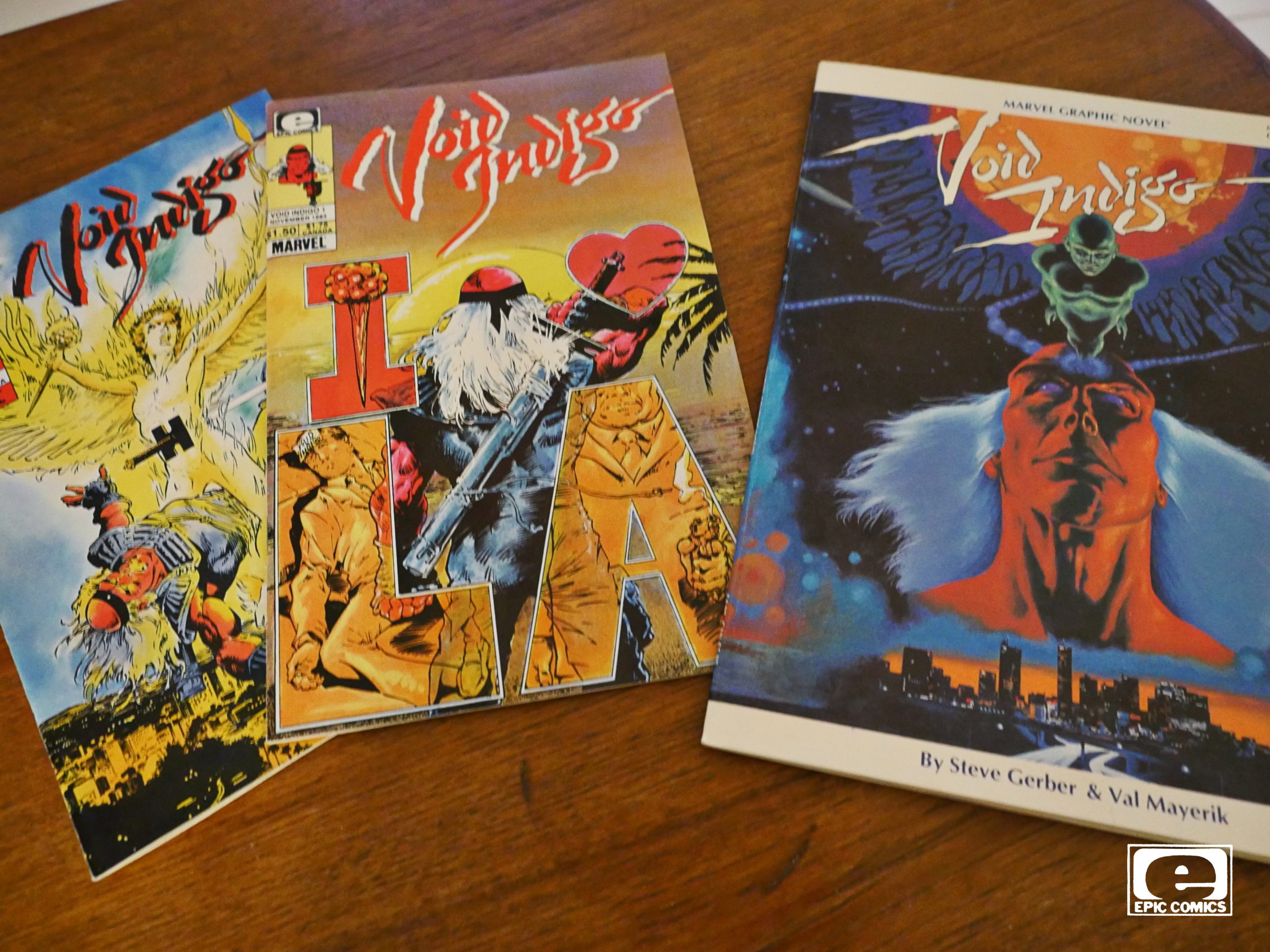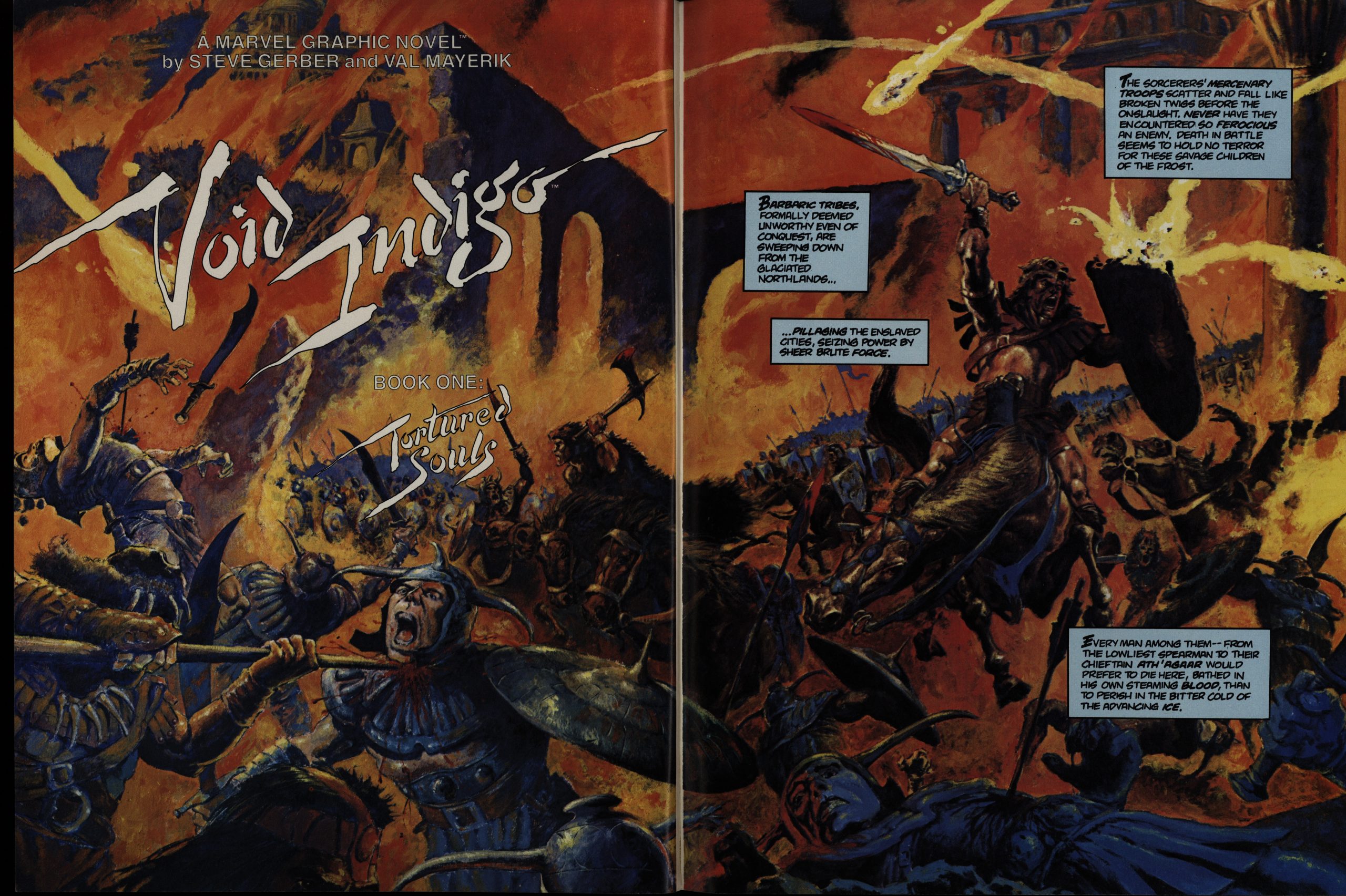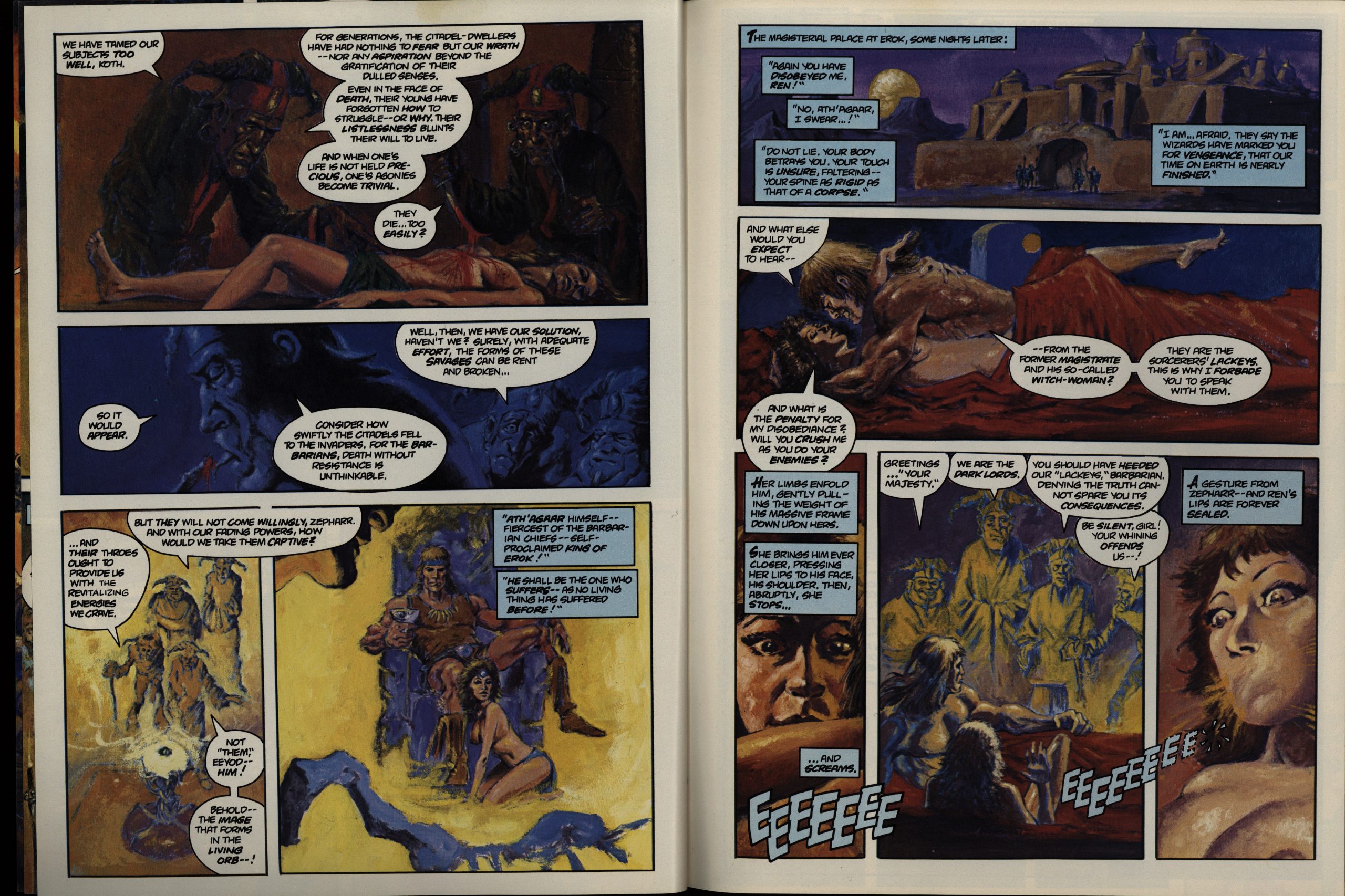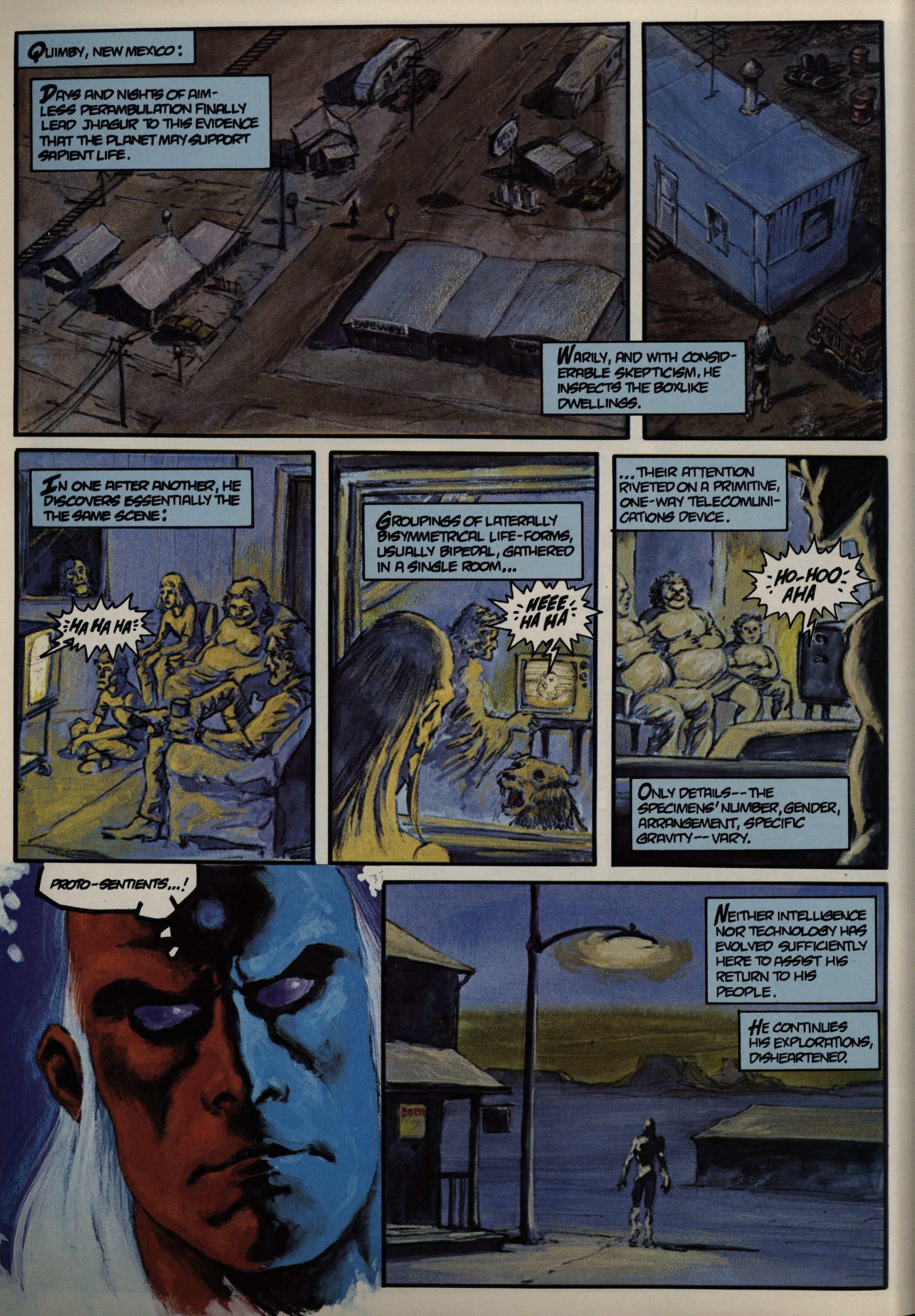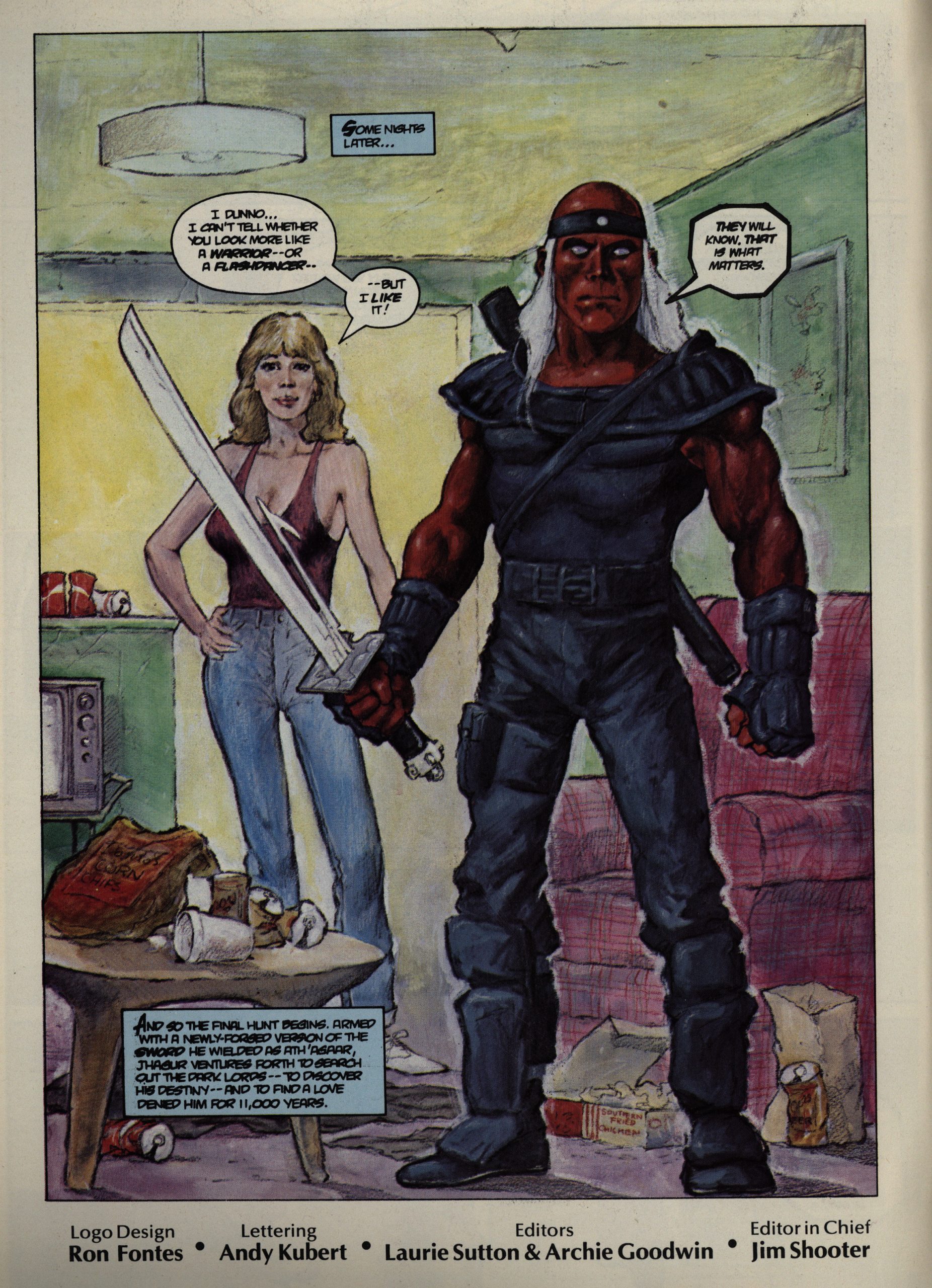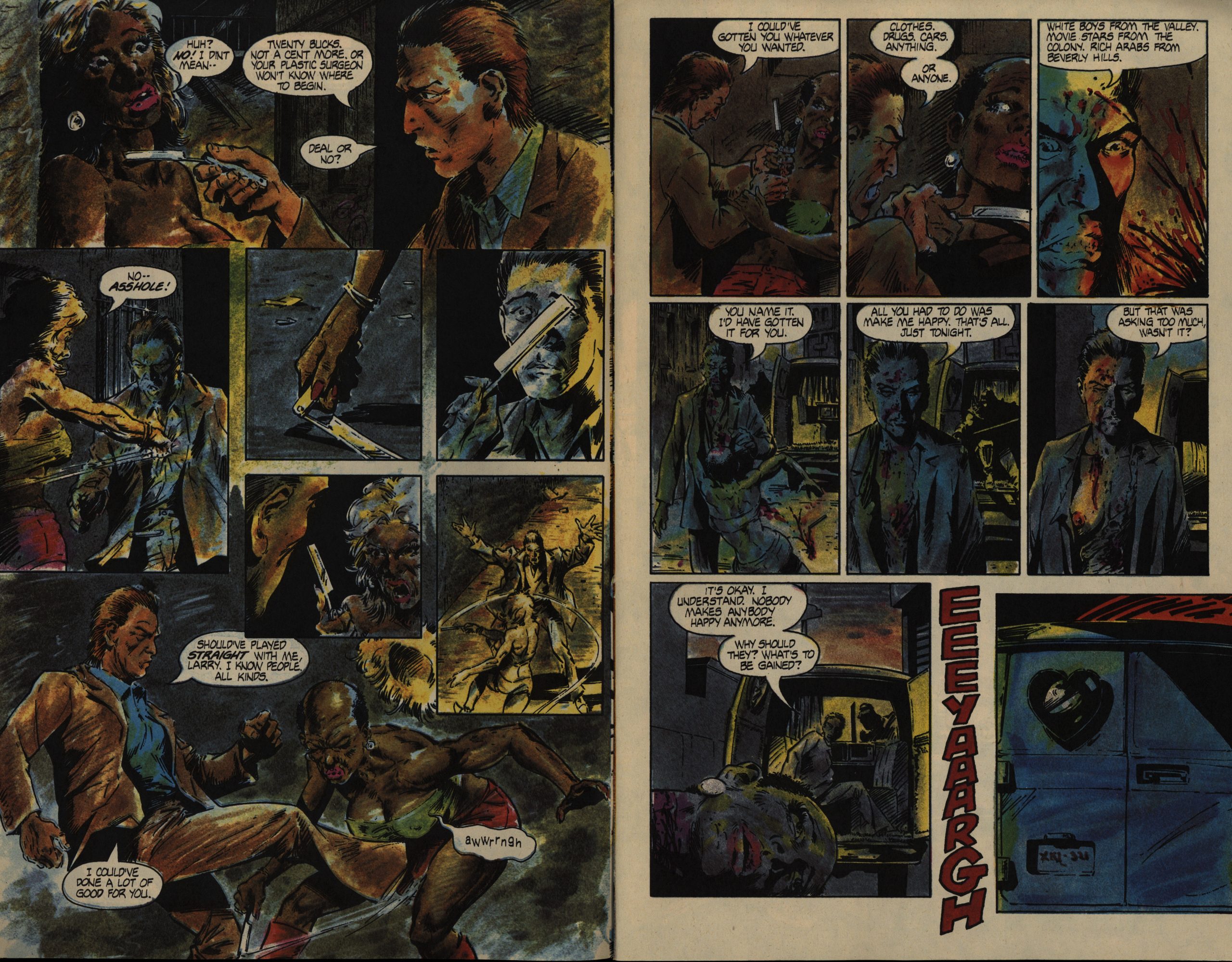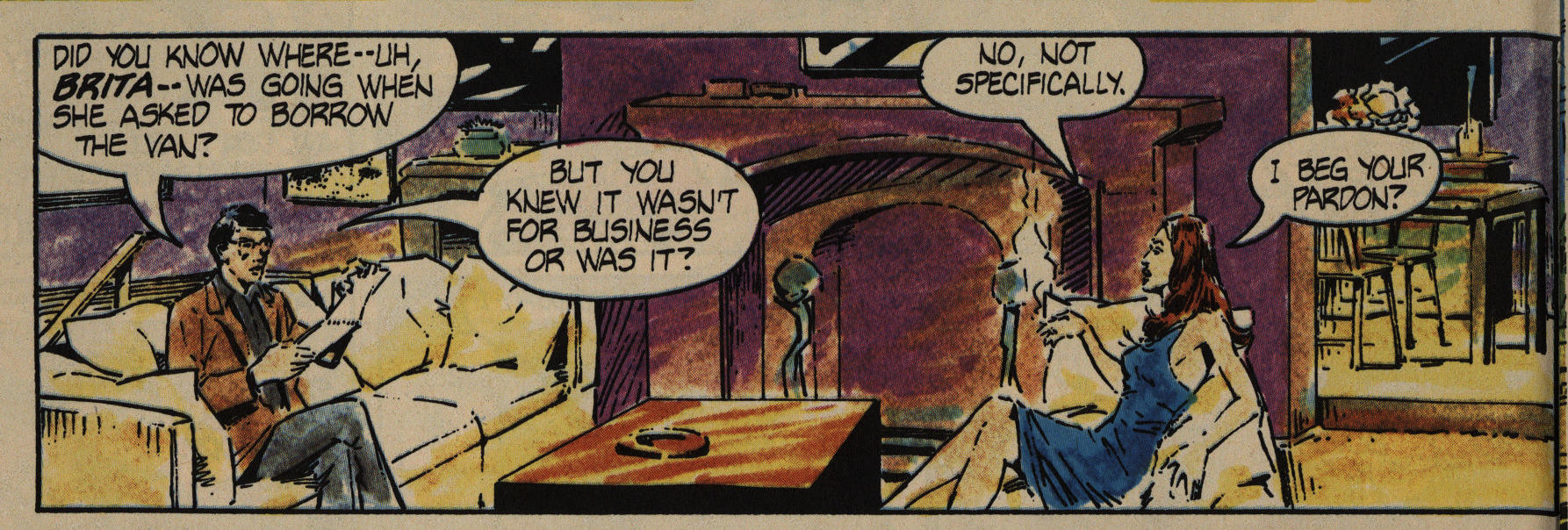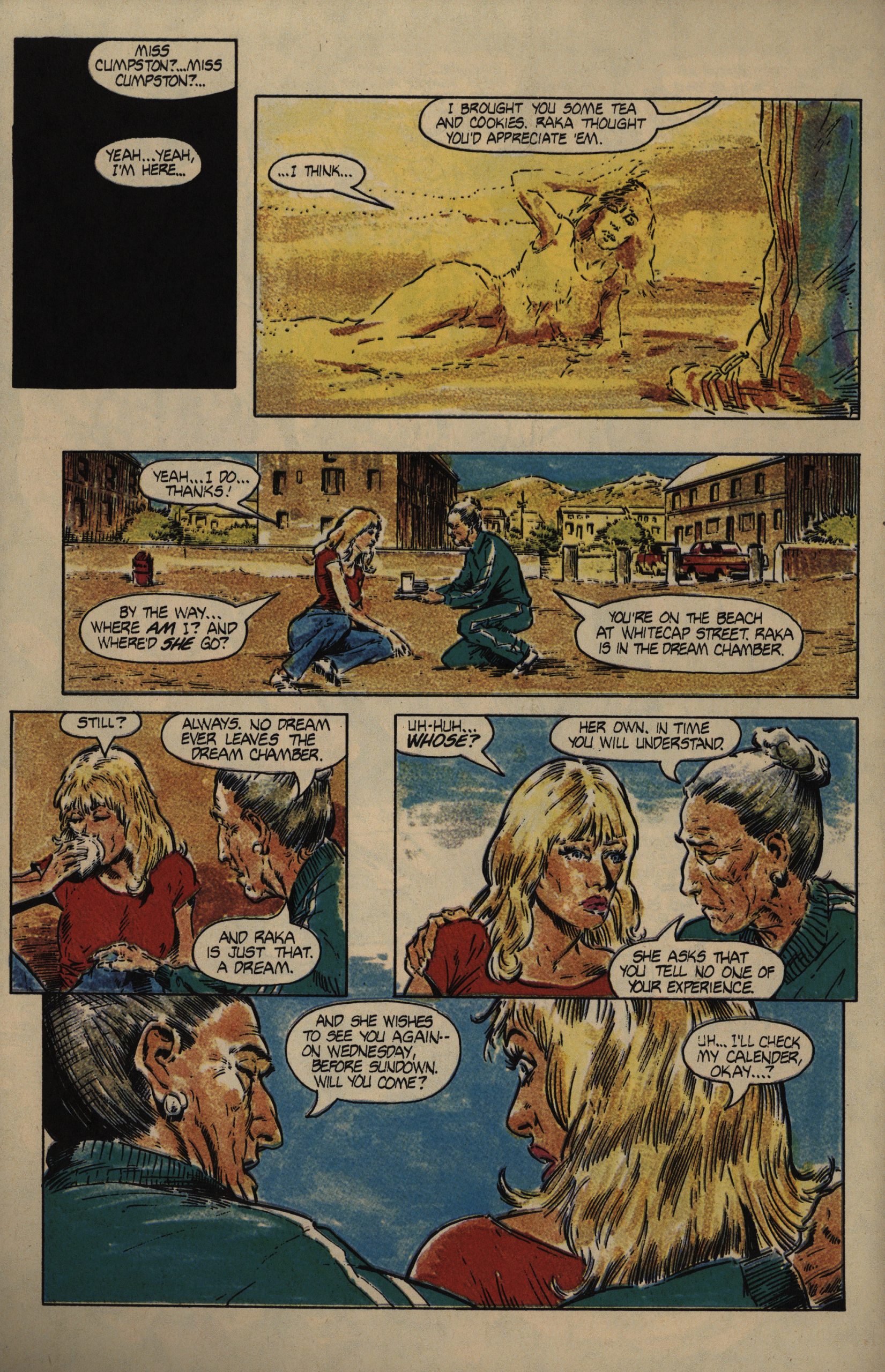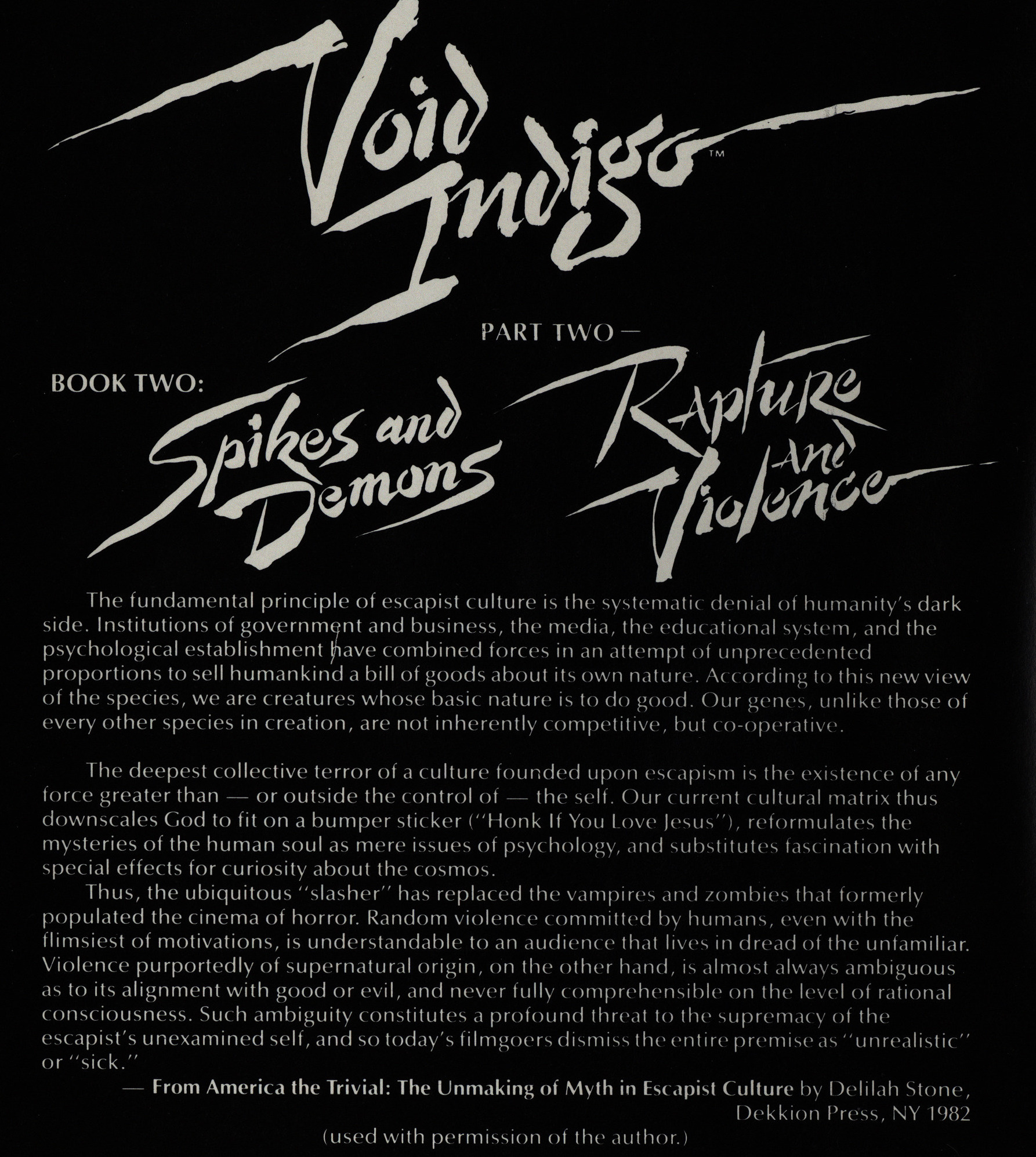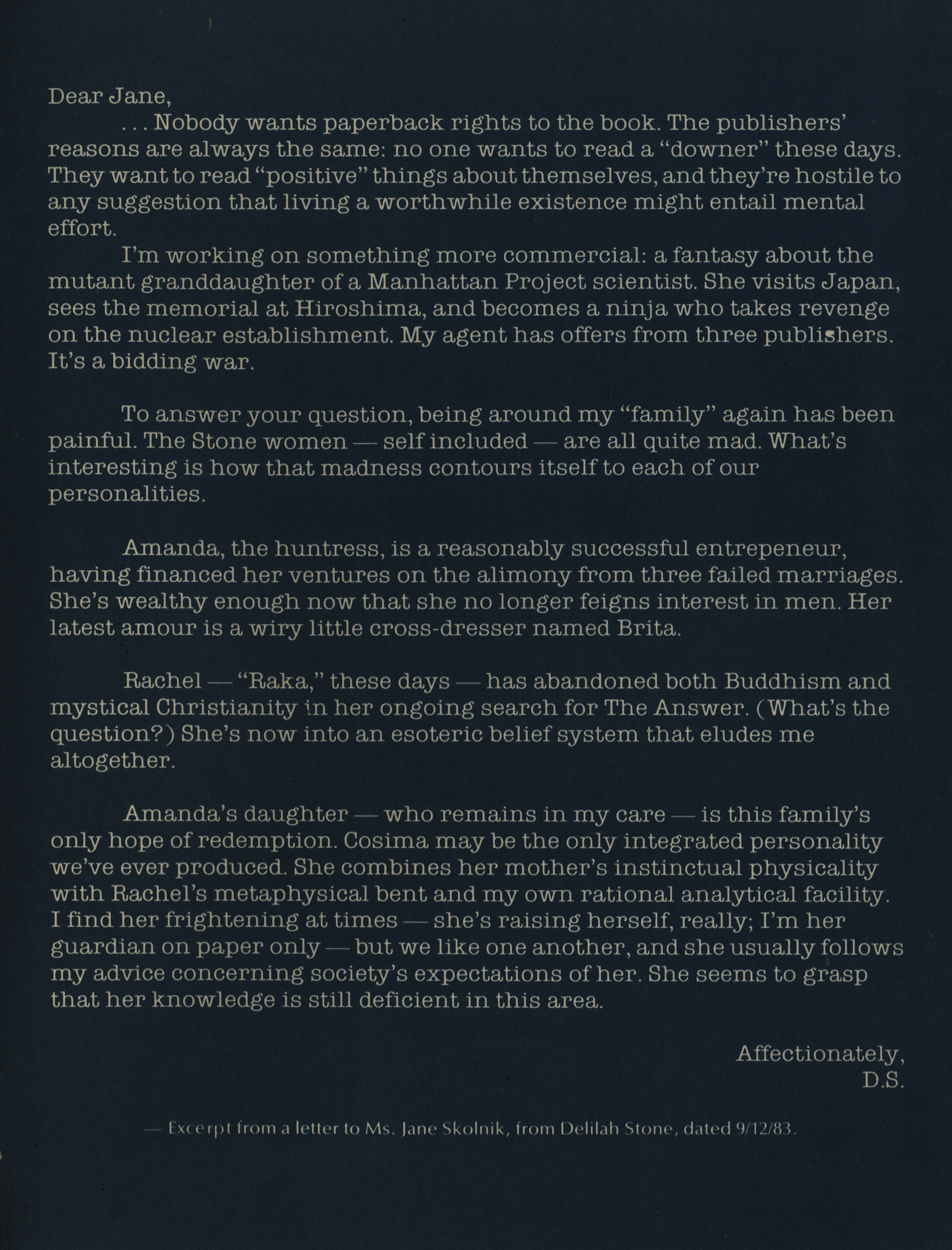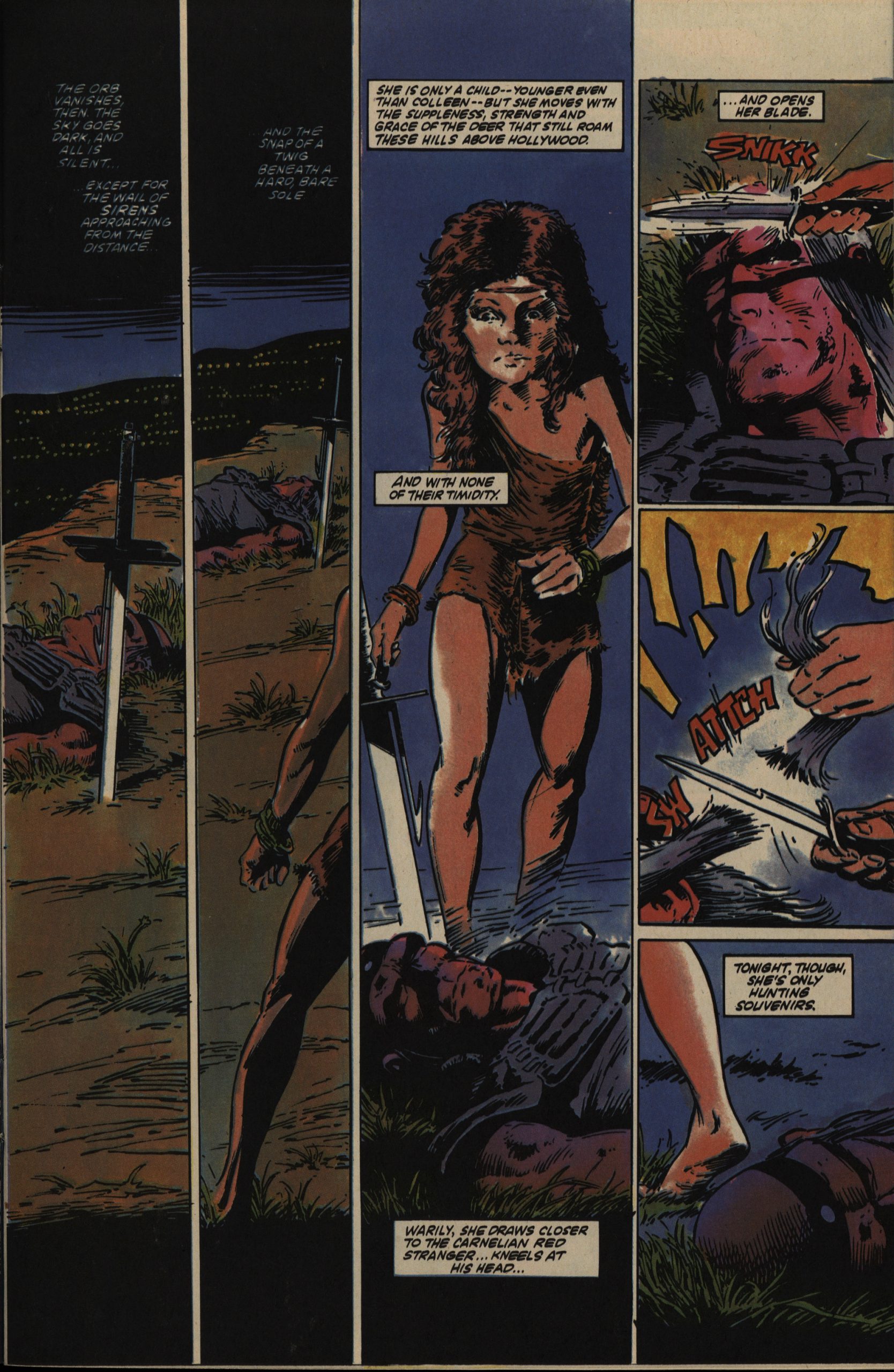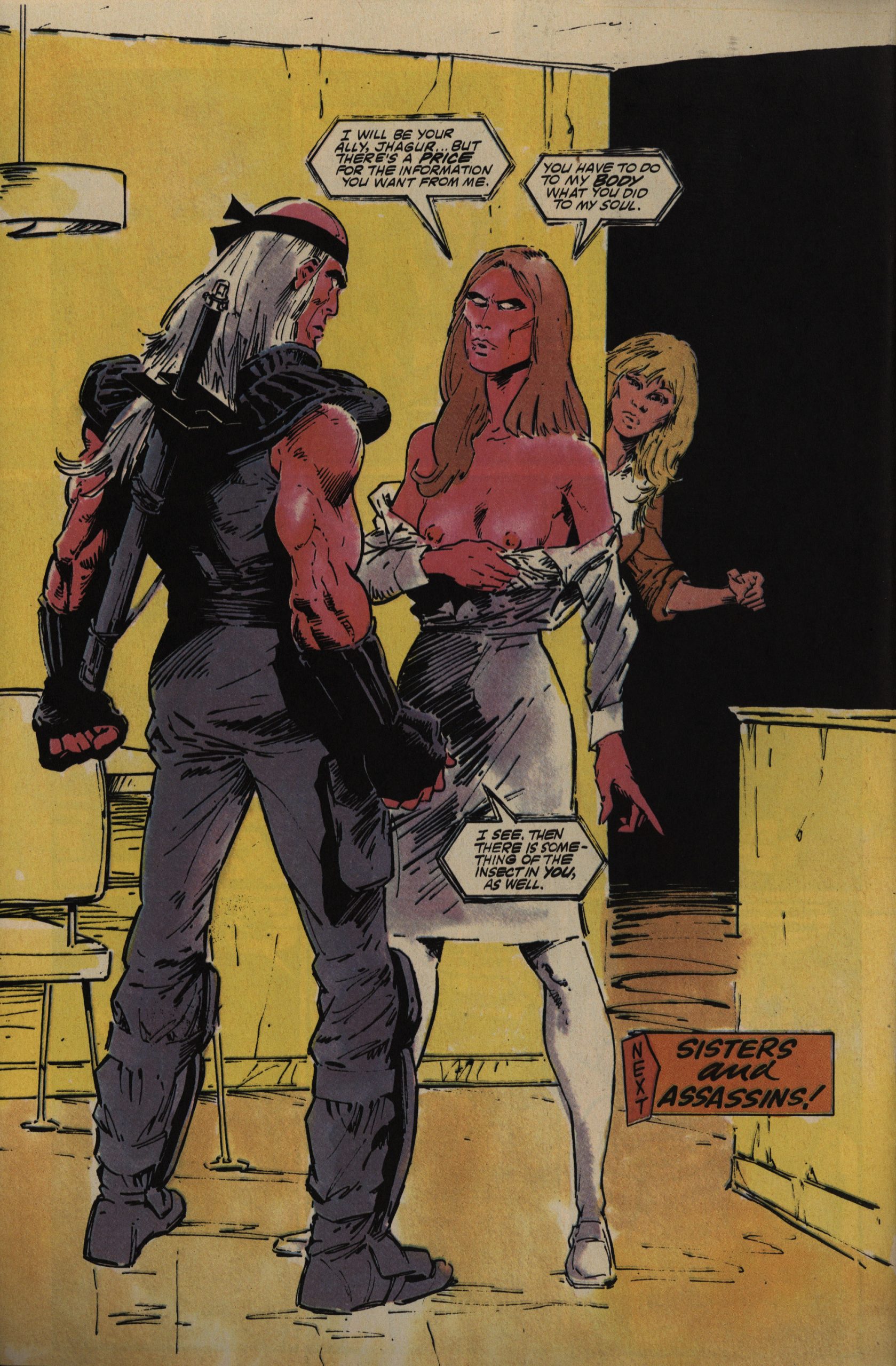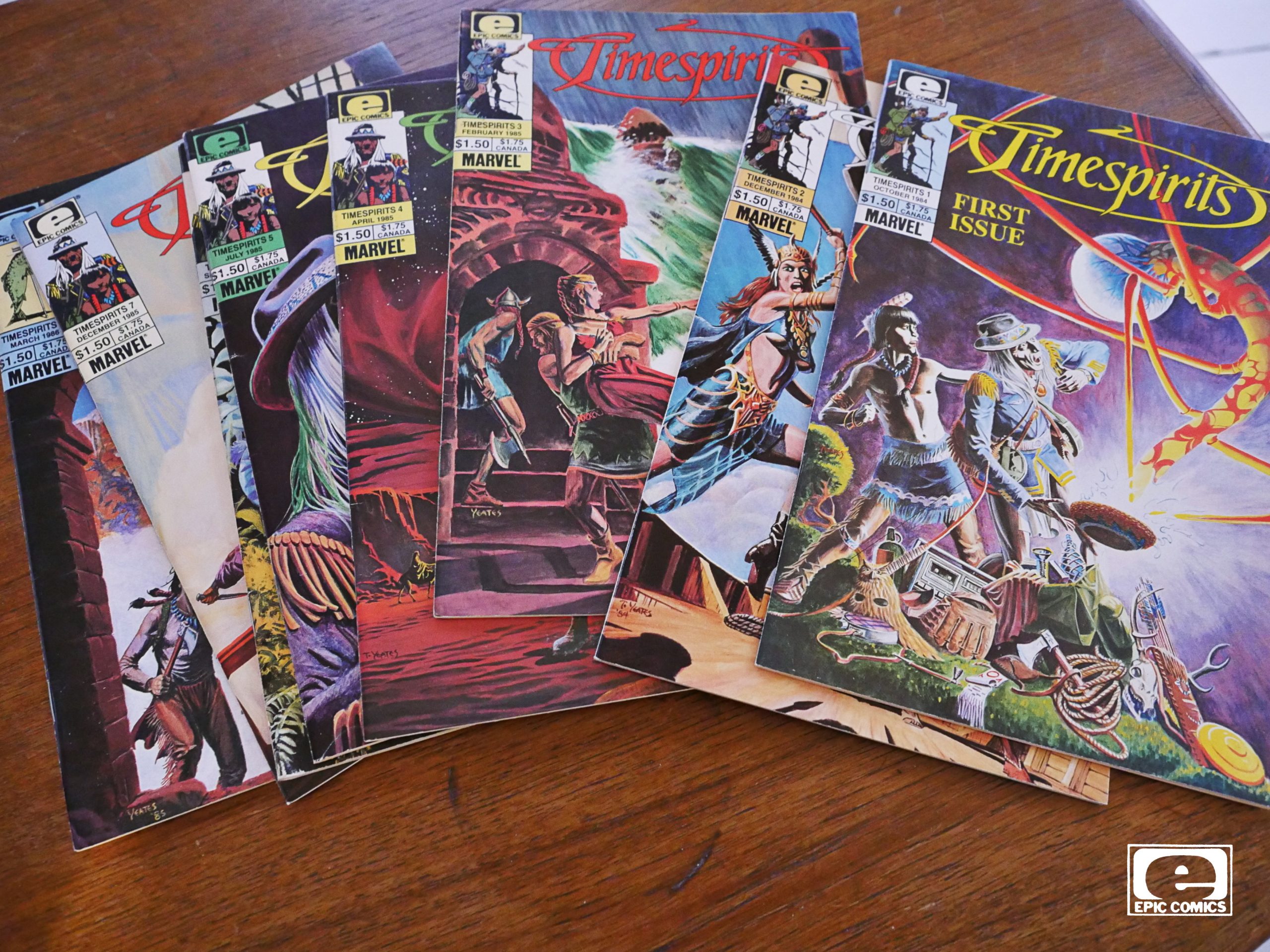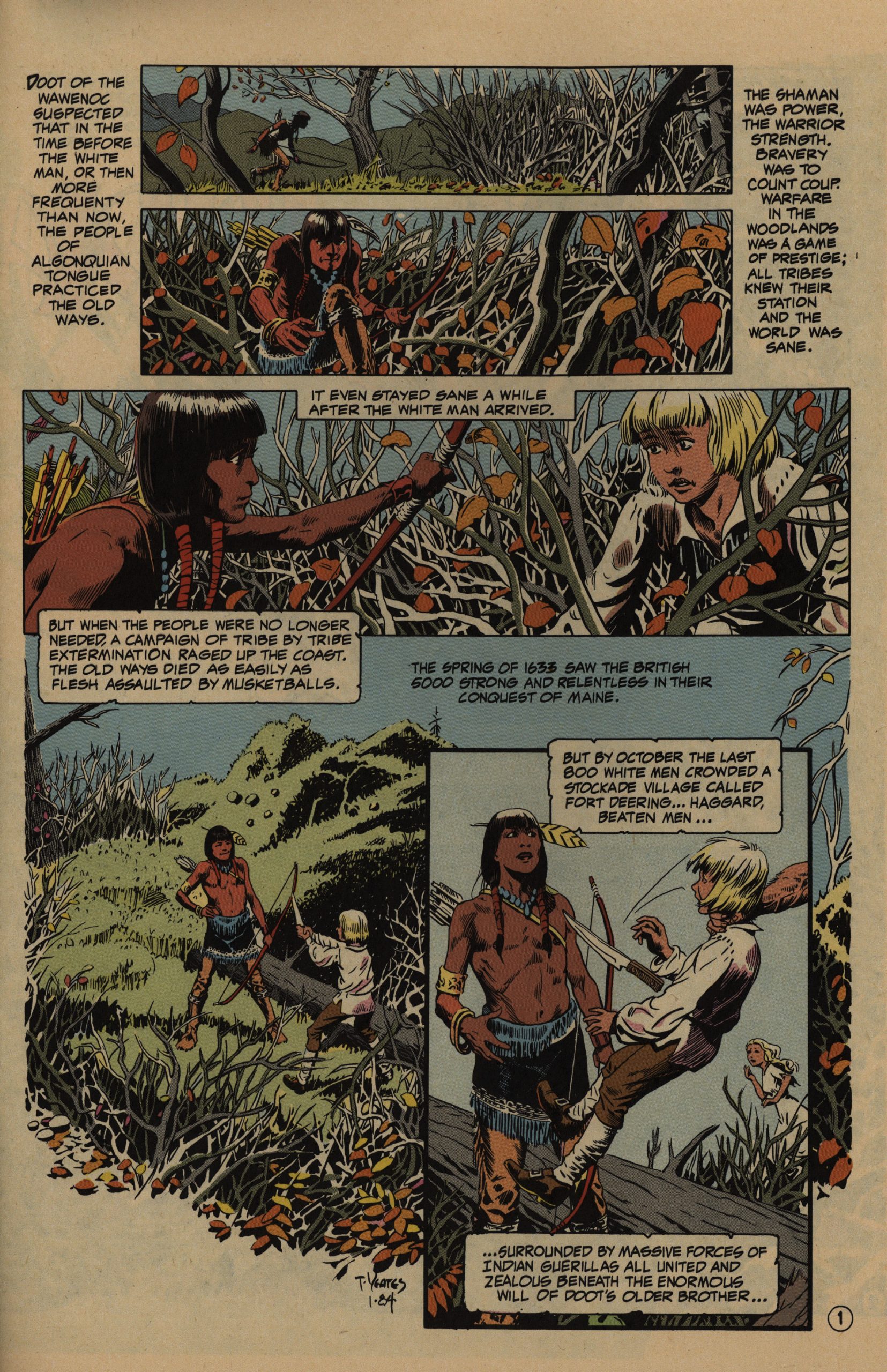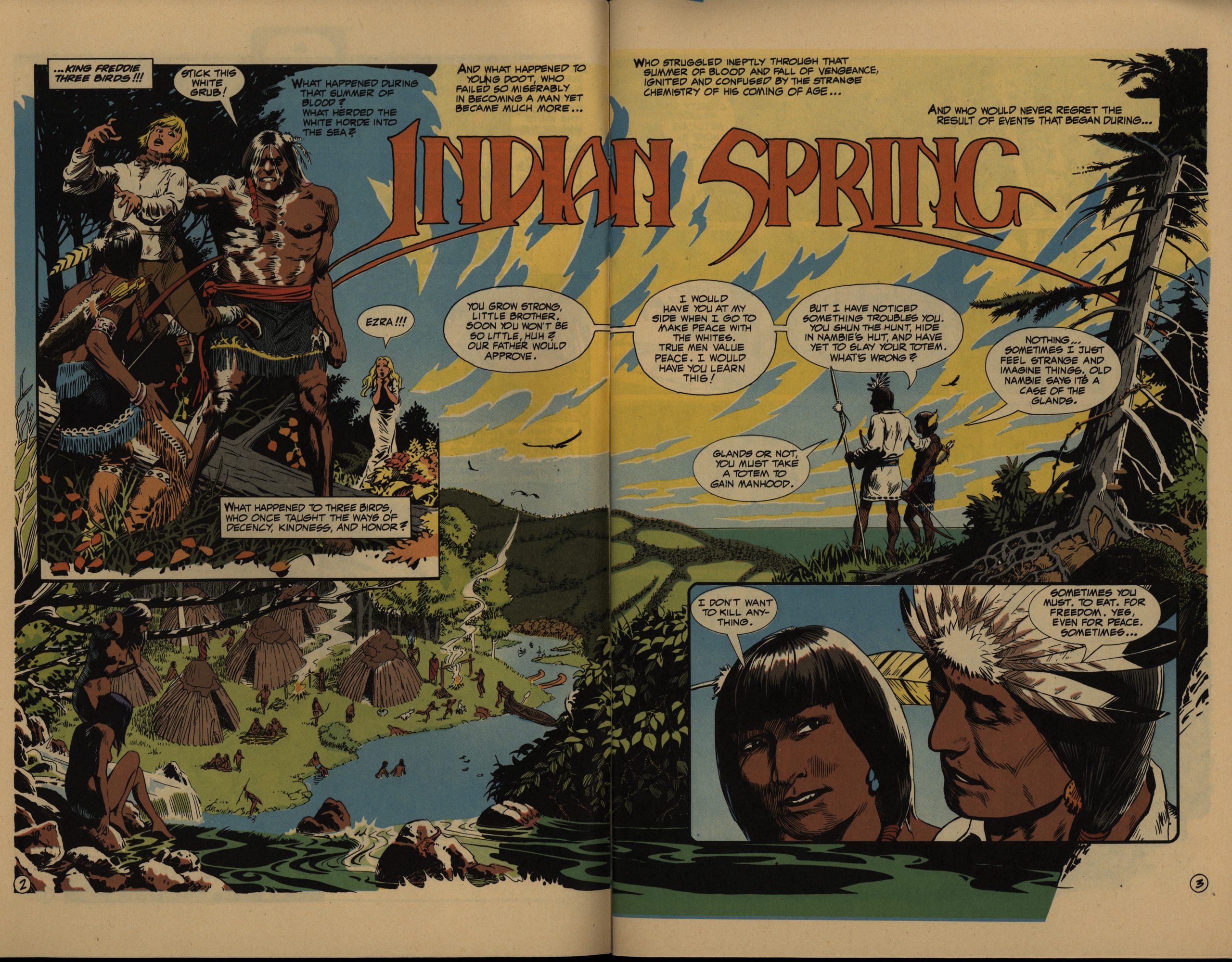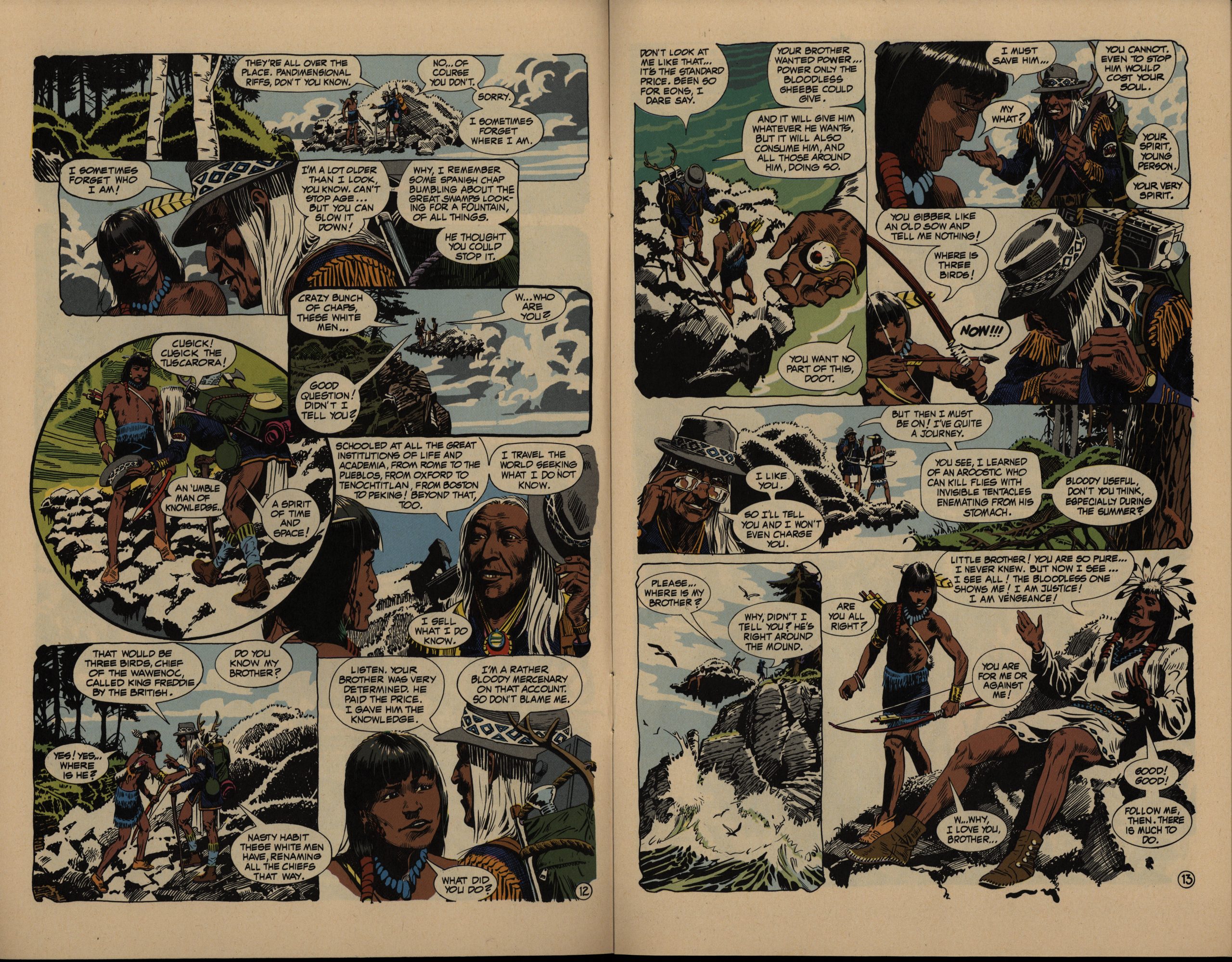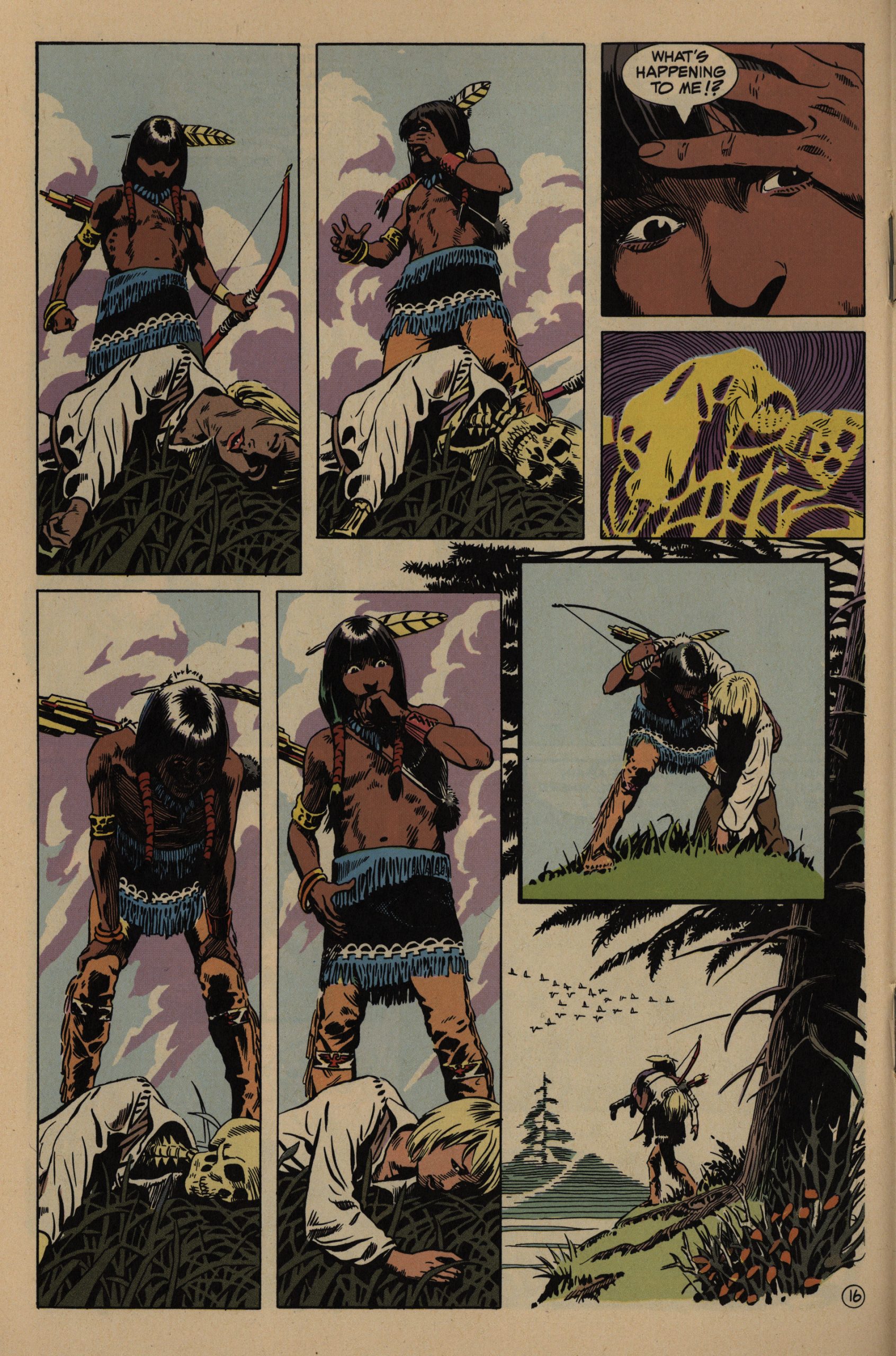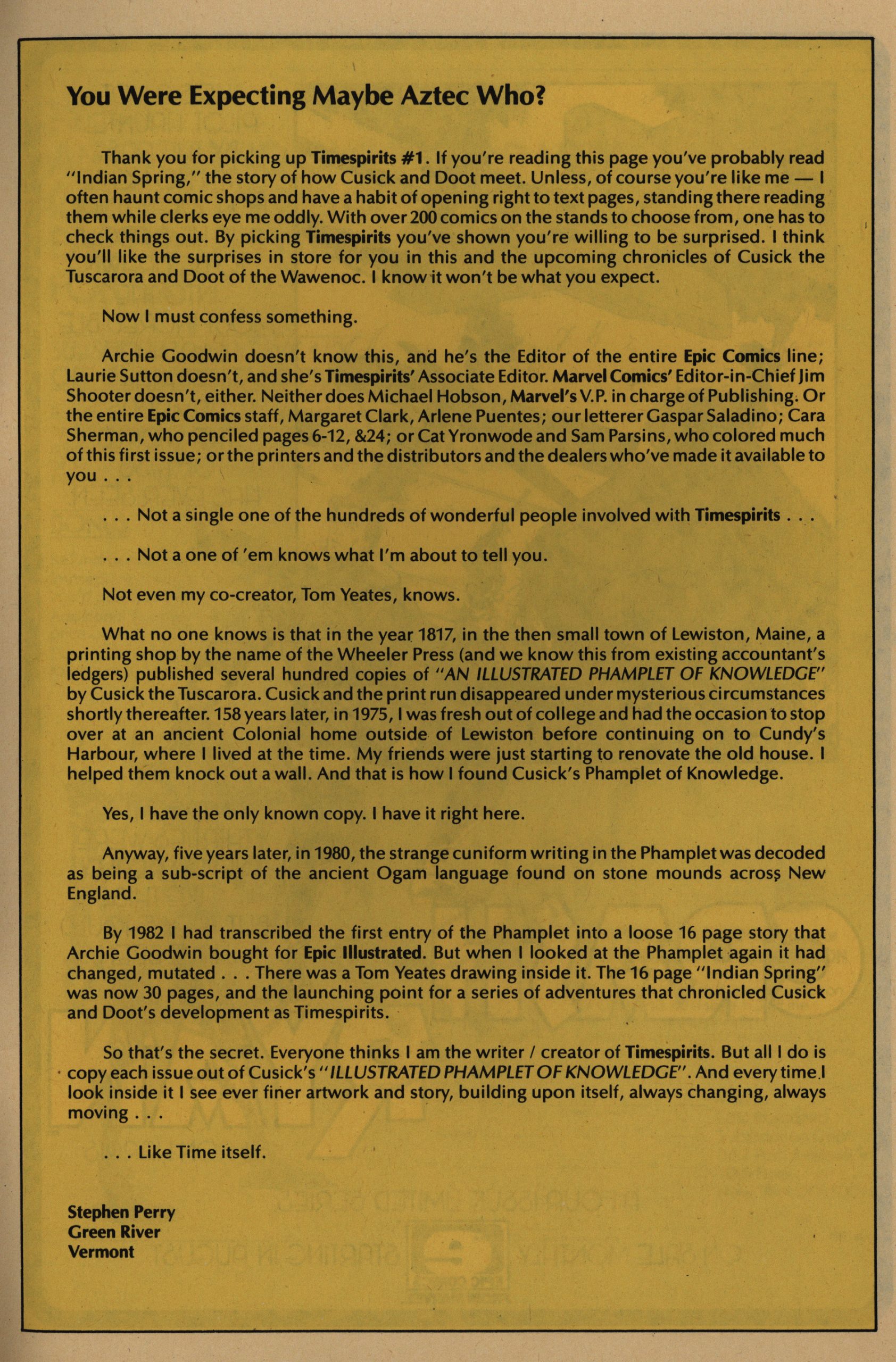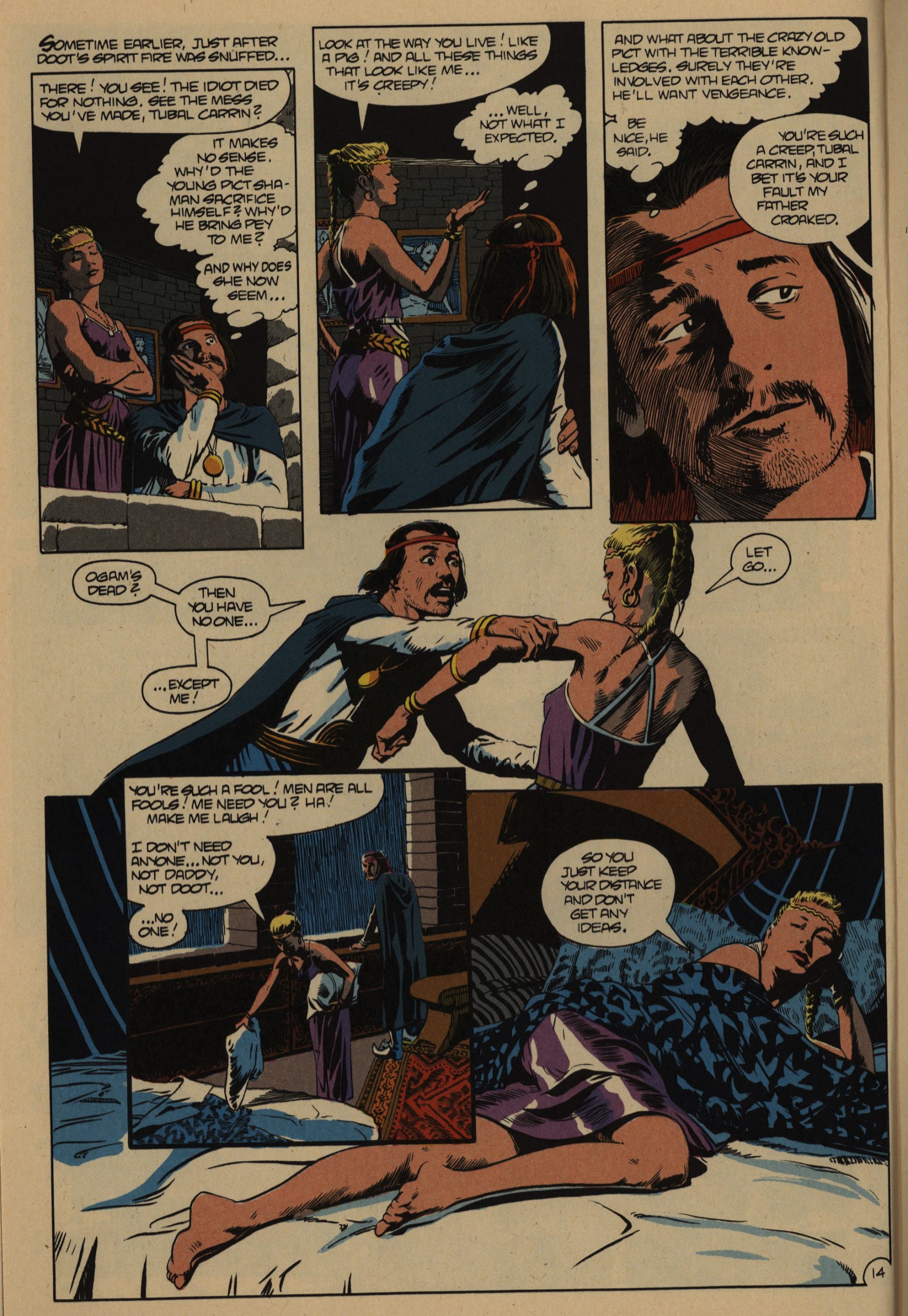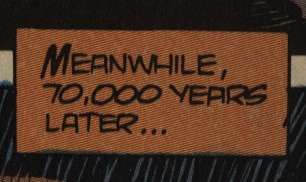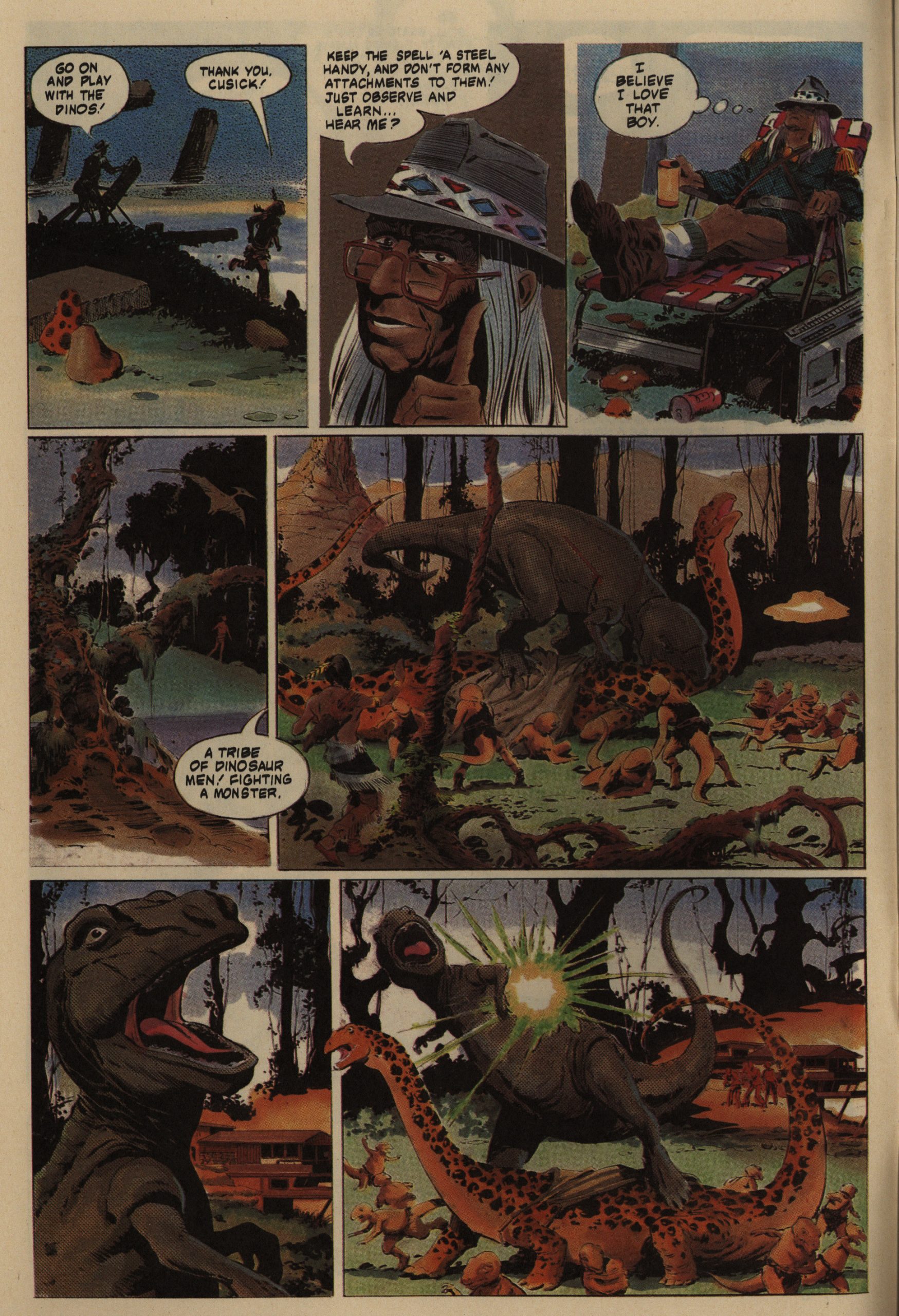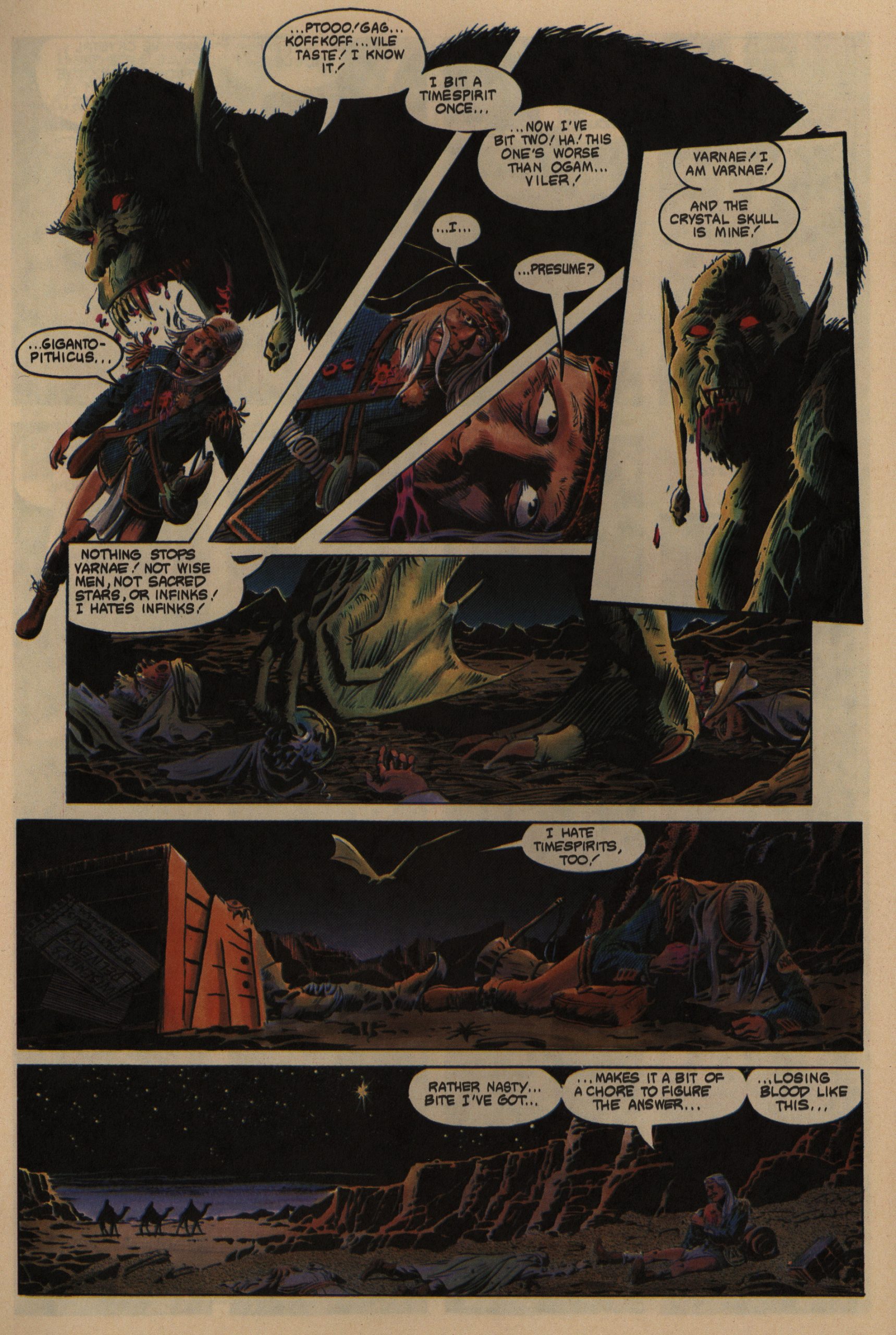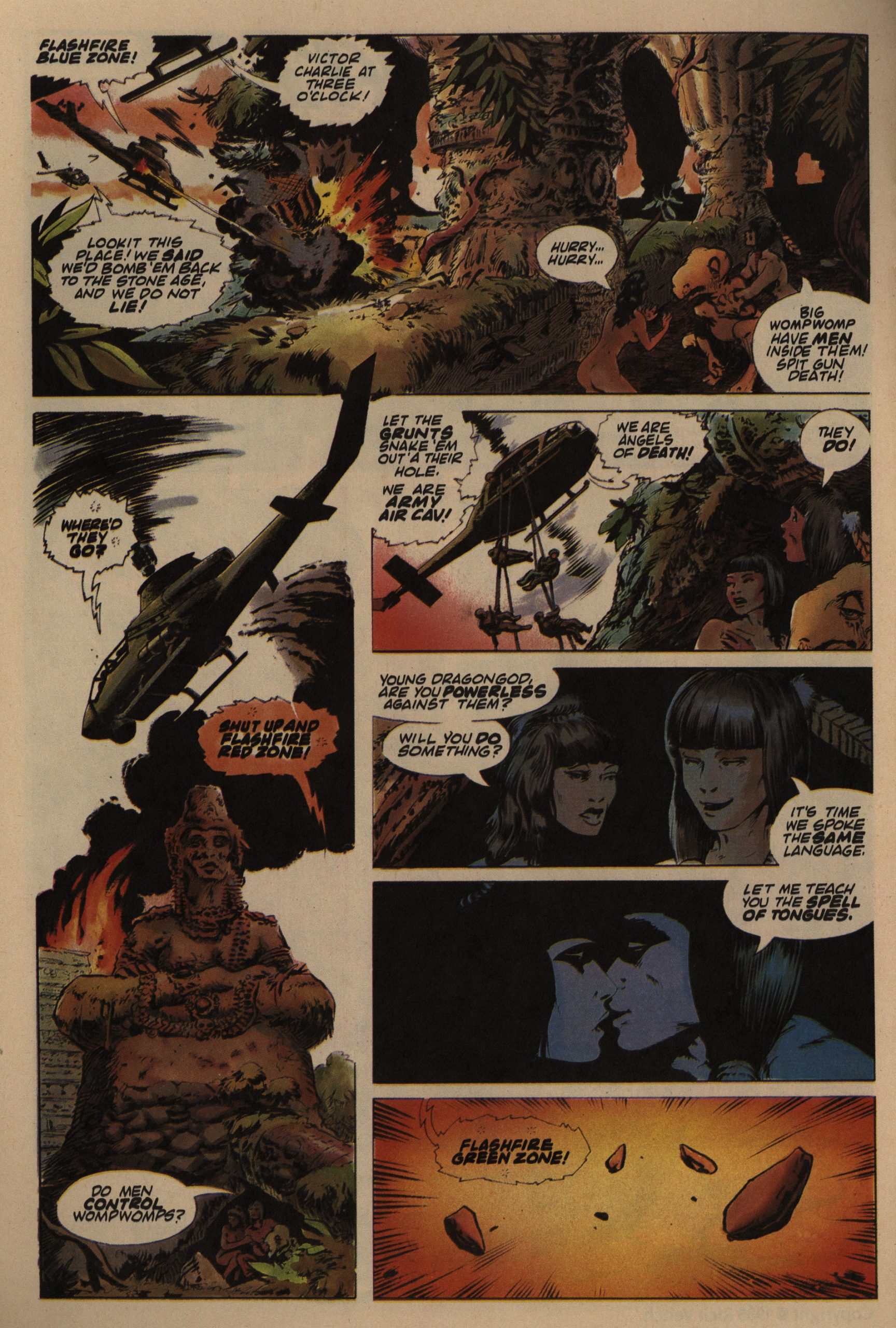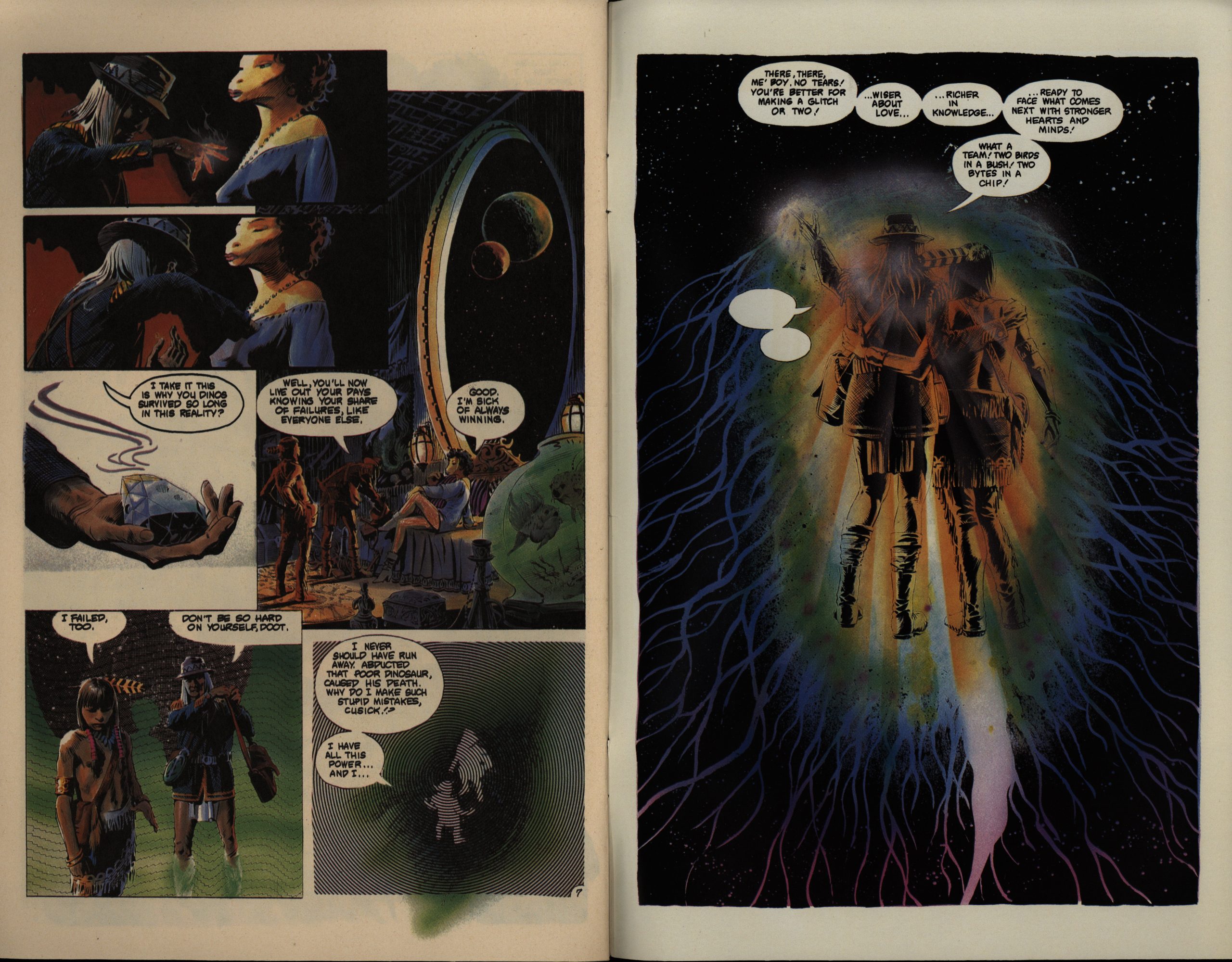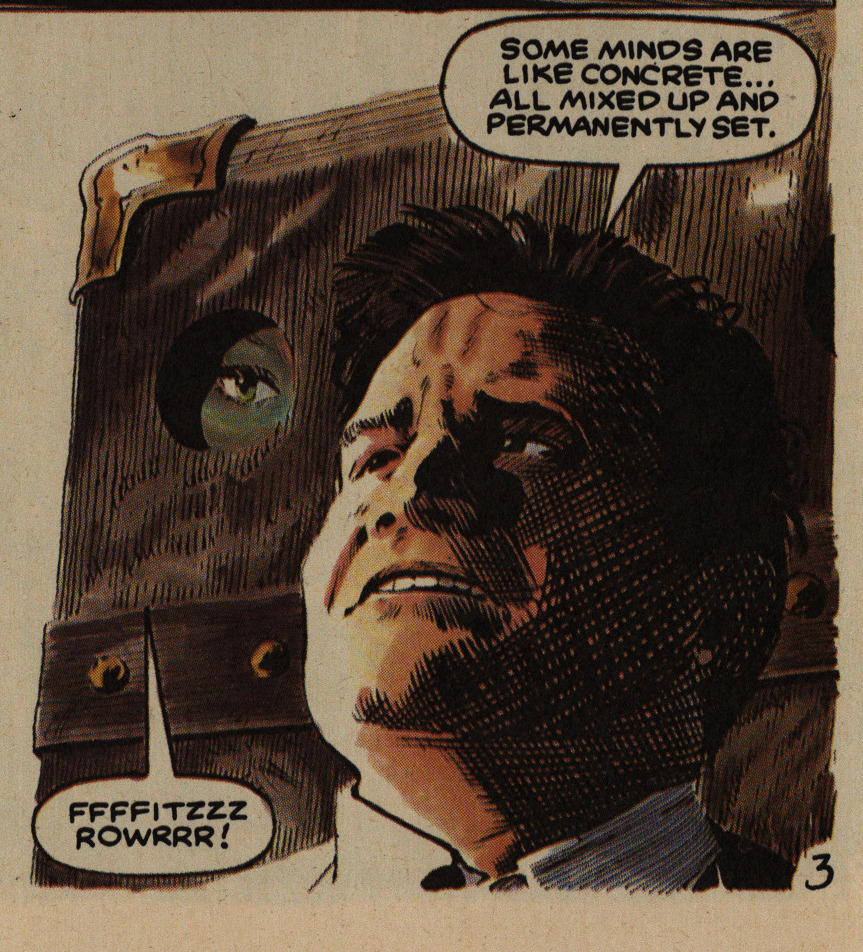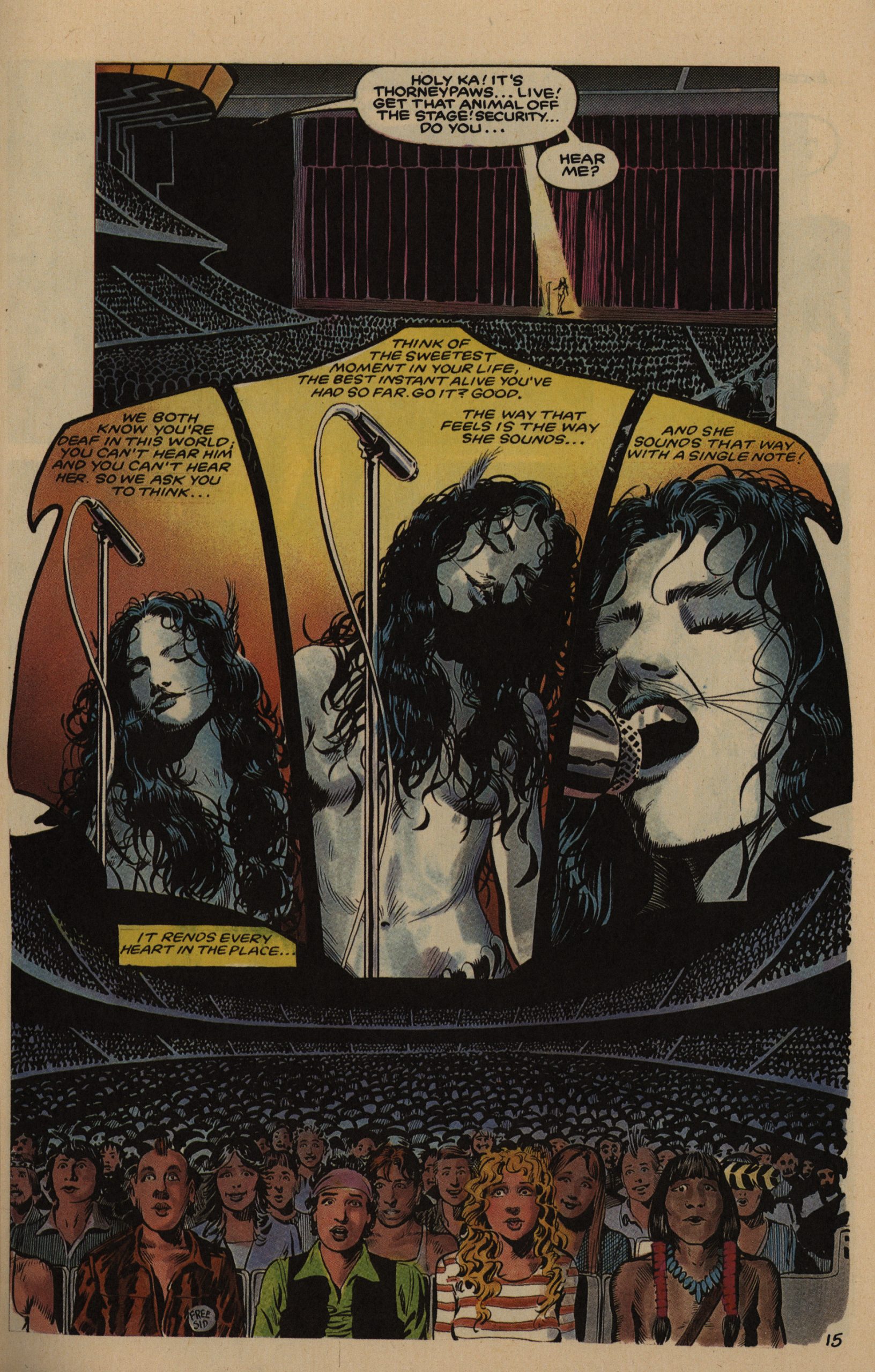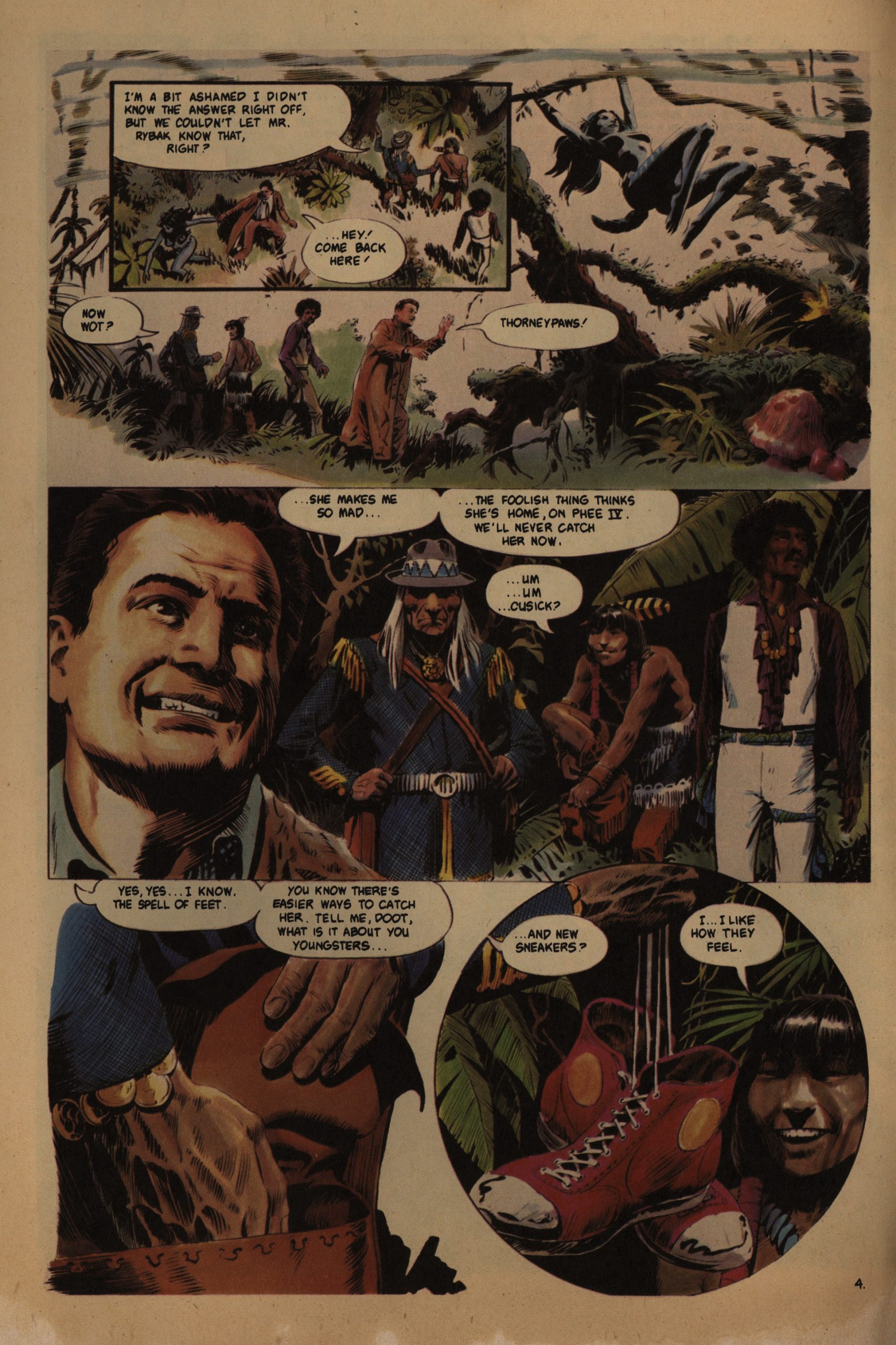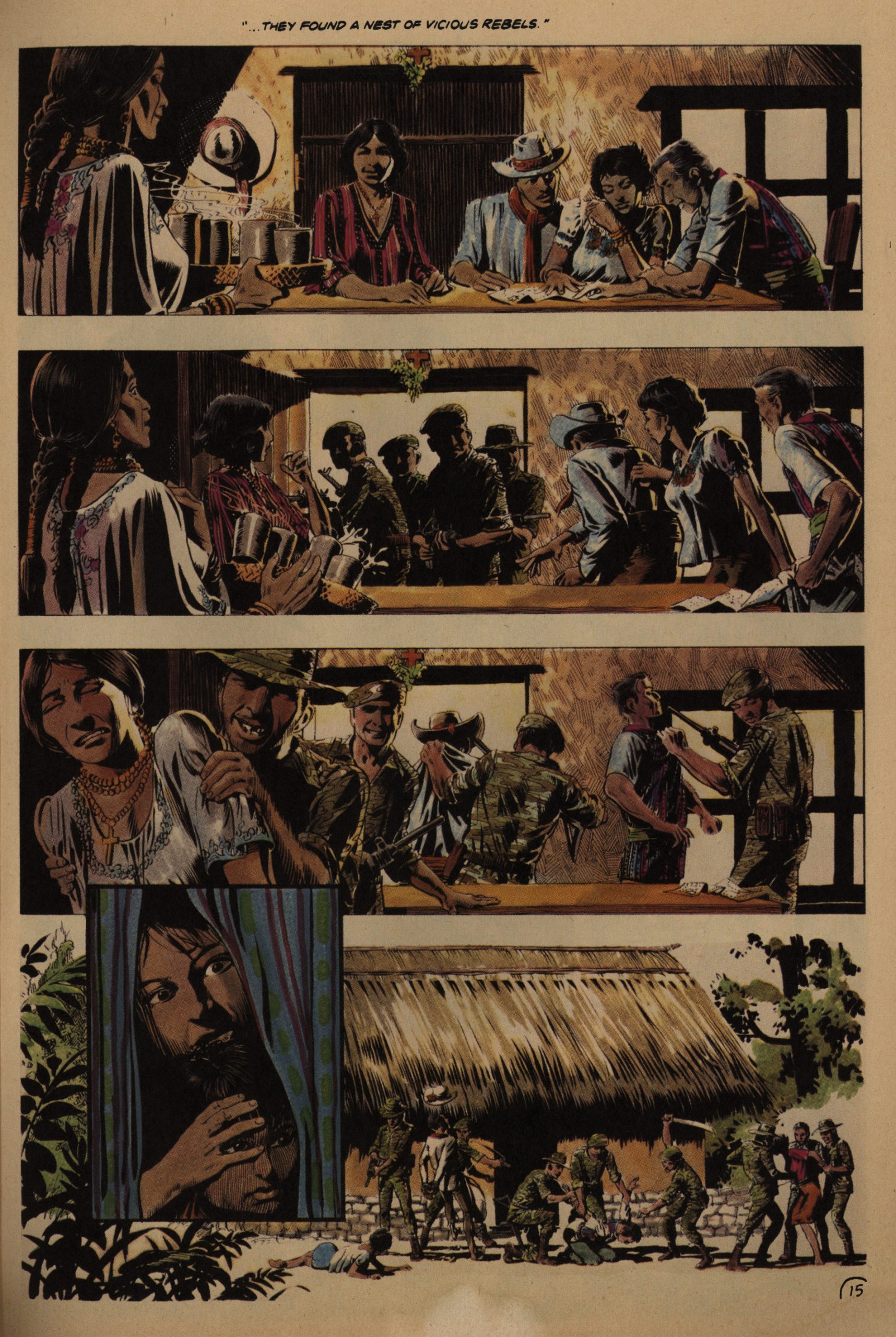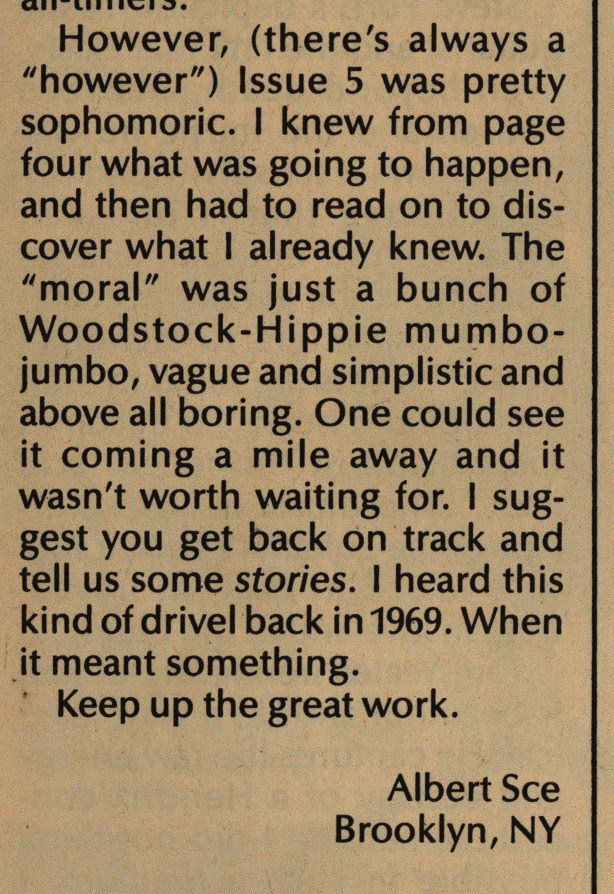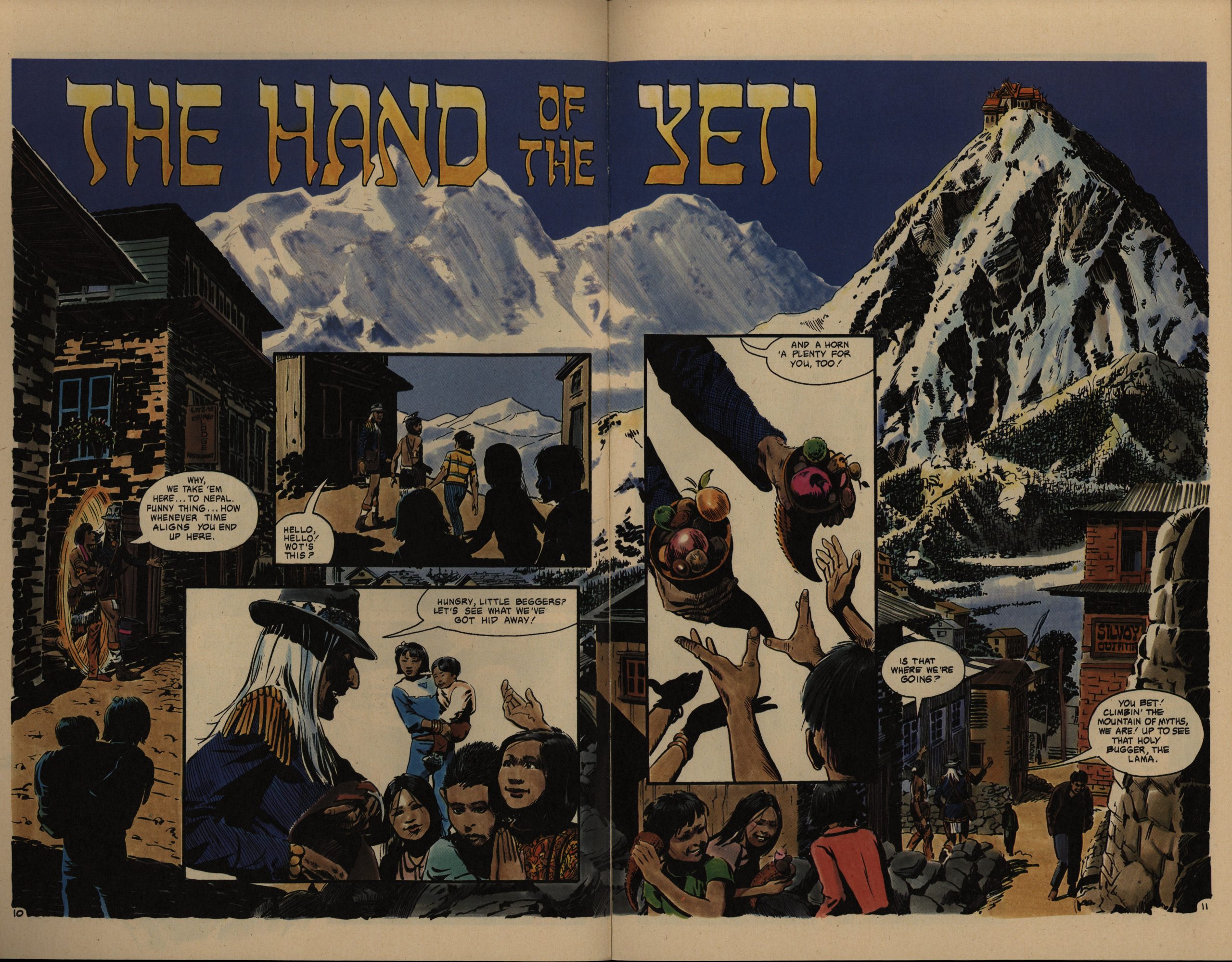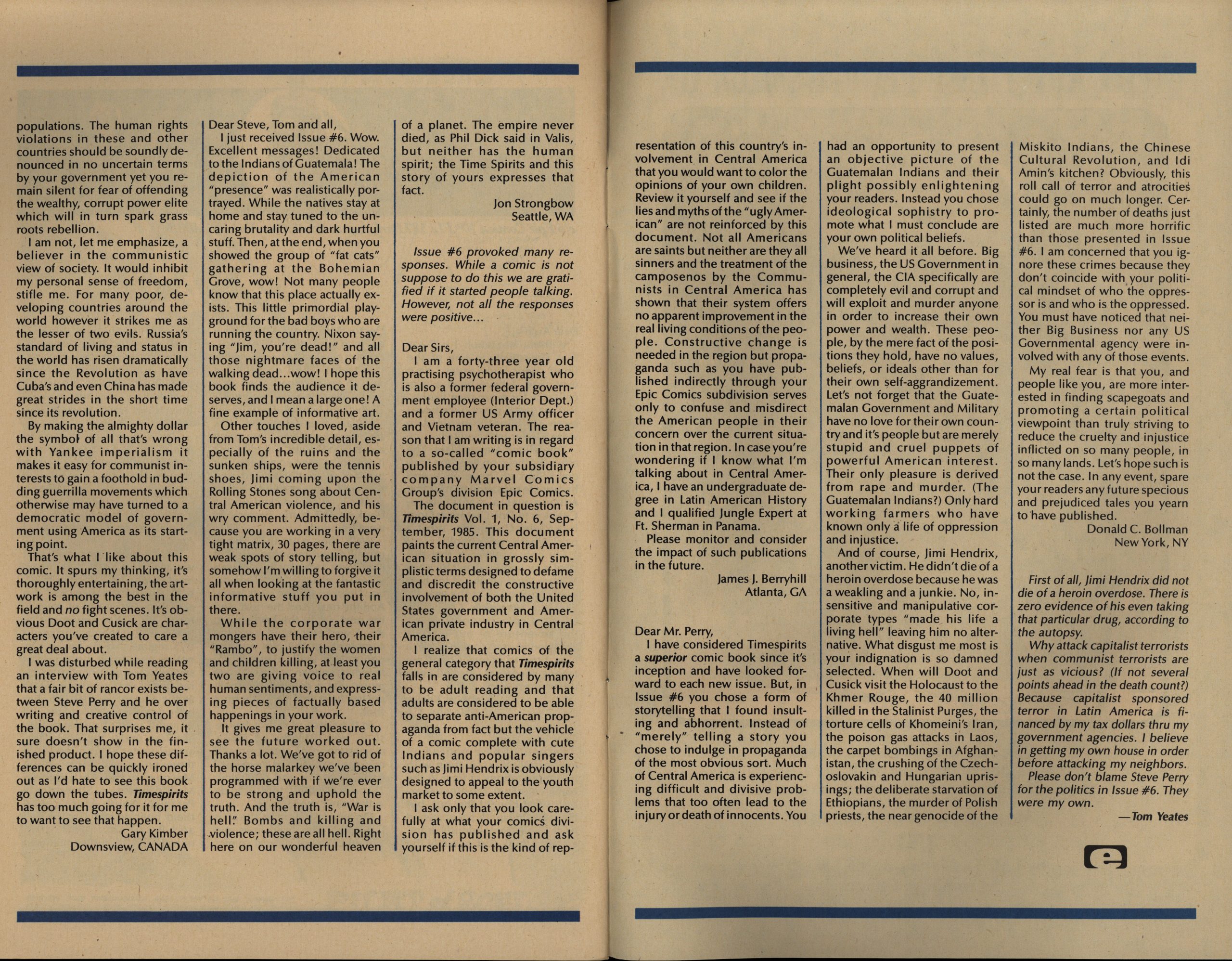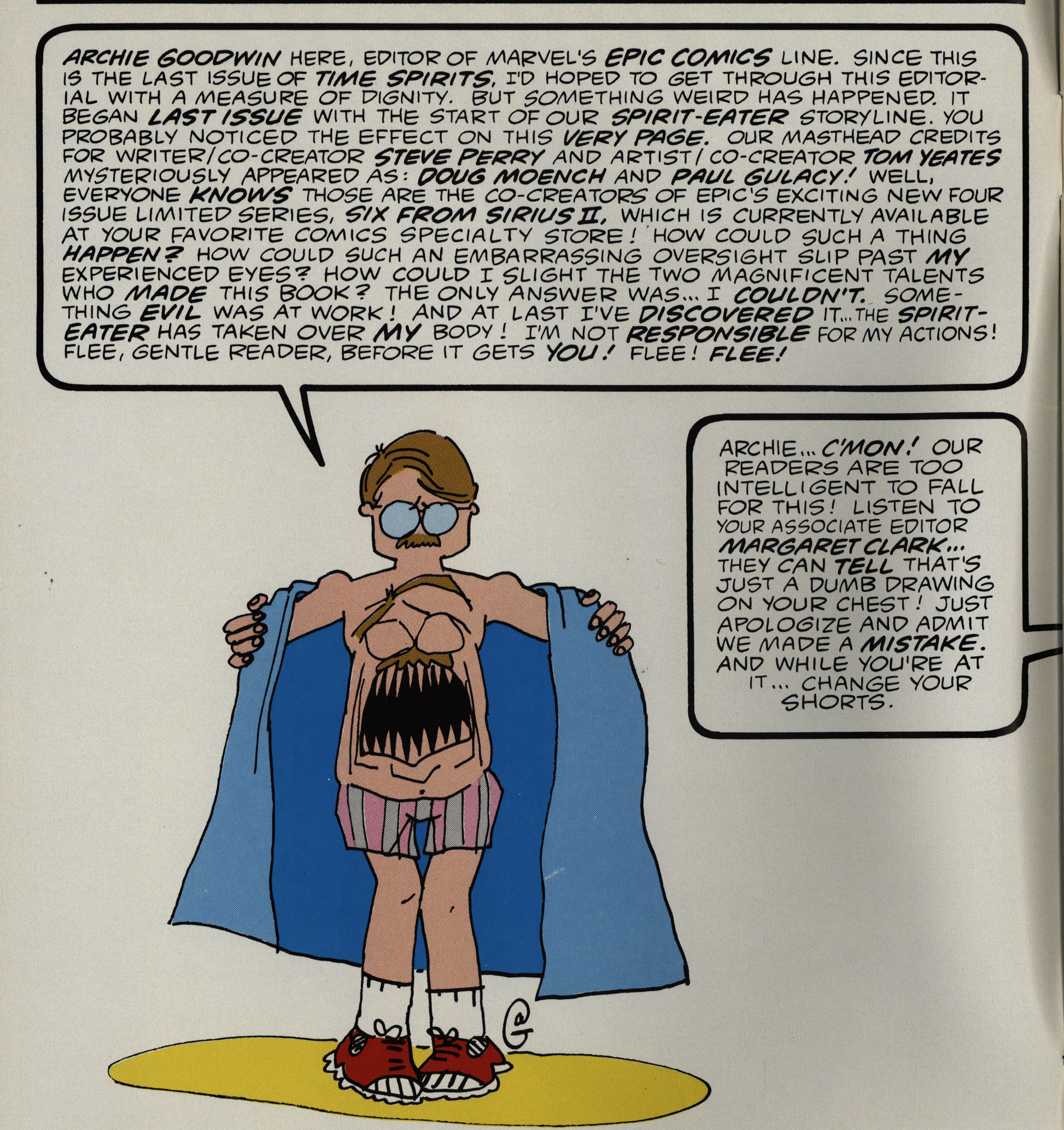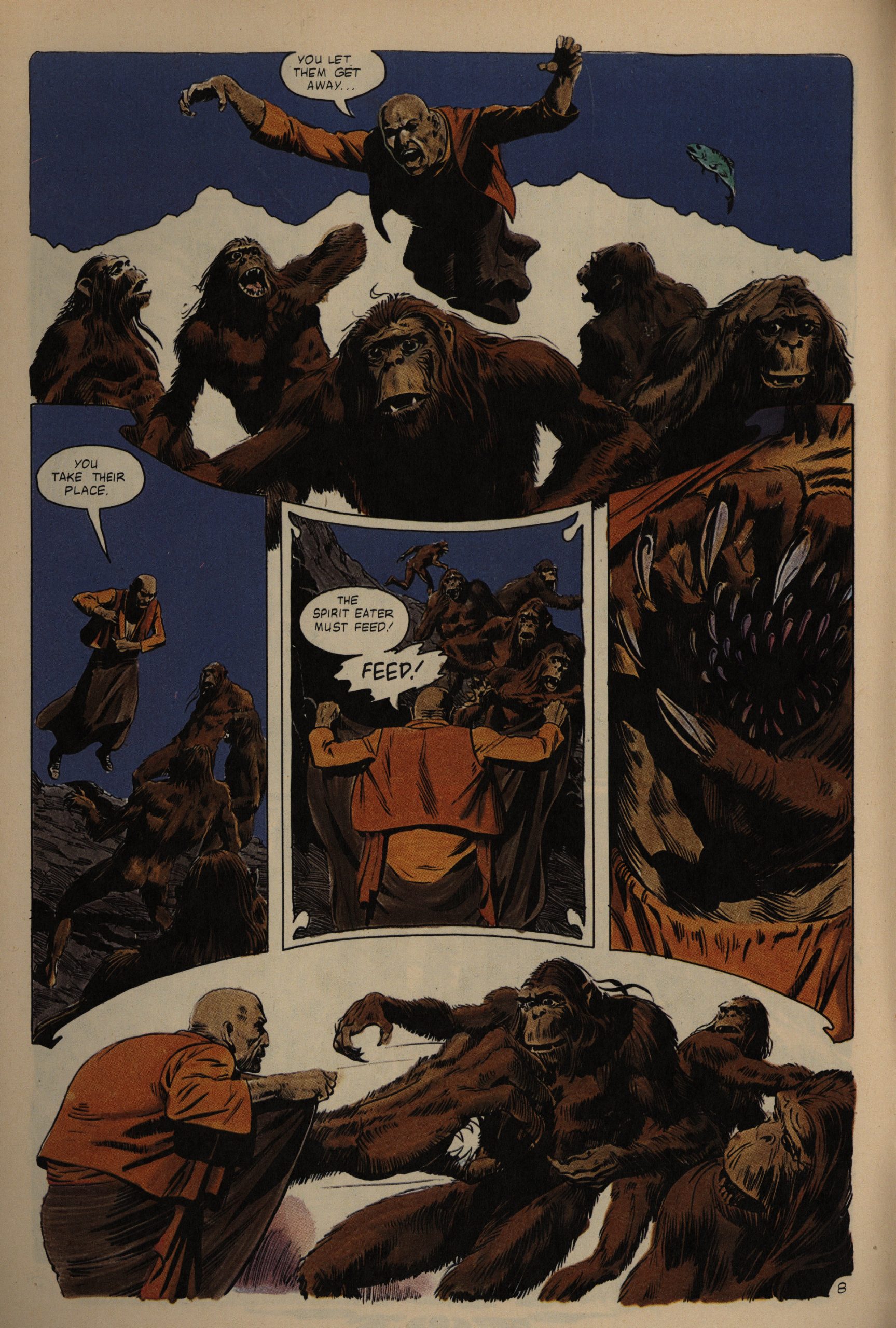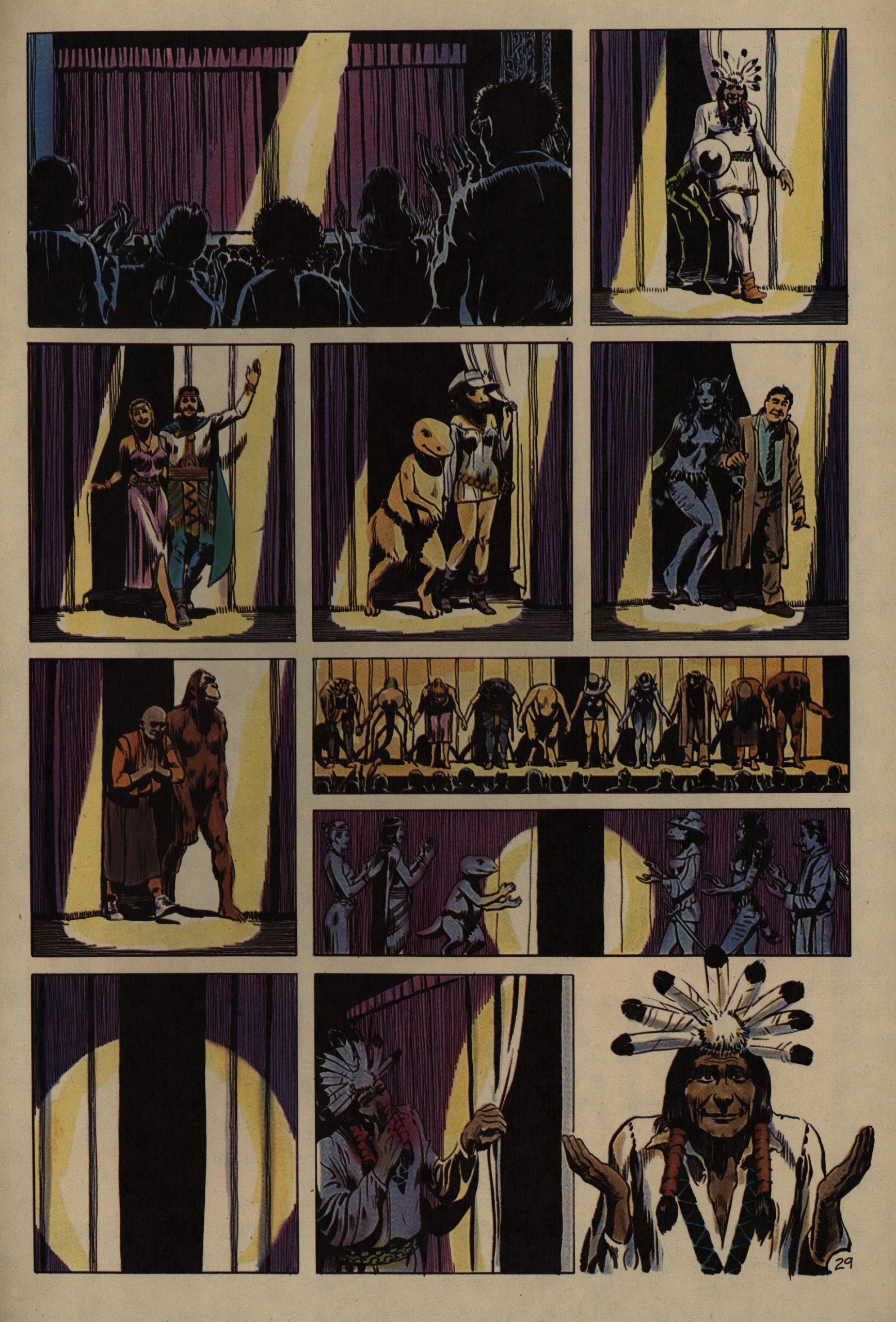Void Indigo (1984) #1-2
by Steve Gerber and Val Mayerik
Ah, the infamous Void Indigo: I remember it being a much talked-about comic at the time… because it was cancelled for being too violent. I think.
I had these issues as a teenager, and I was not a fan. I was rather squicked by it all.
Steve Gerber famously left Marvel in the late 70s, and sued them for ownership of the Howard the Duck character, so there was a lot of bad blood between them. But Epic Comics was formed as a way to lure writers such as Gerber back into the fold, with Archie Goodwin supposedly forming a firewall between the creators and the other Marvel people (especially Jim Shooter, who many felt were responsible for their miserable Marvel experience).
Before the Epic Comics series, Marvel published a Void Indigo graphic novel. In retrospect, it’s a weird way of introducing a series, but back in the mid 80s, companies were trying out a bunch of different publishing models. Gerber and Mayerik certainly make their intentions known from the start: We open with a fully-painted spread of violence and mayhem.
Oh, that scene I still remembered from when I last read this over 30 years ago. (And the torture starts on the next page, but I’ll spare you that: It’s vile.) There’s something about mouths disappearing that’s particularly nauseating to me.
The murder and torture is just the preamble, though: Then we go to Earth and our protagonist meets use proto-sentients.
As a graphic novel, it’s… not. It reads like what it is: A superfluous barbarian super-hero origin preamble. Nothing much interesting happens in it, and it’s practically devoid of structure. It’s by no means a satisfying reading experience, and Mayerik’s painted artwork isn’t as accomplished as his pencil-and-ink artwork. He’s always had a problem with human proportions, and head size/body size proportions are perpetually off and fluctuating.
So that’s not an auspicious introduction to Void Indigo… especially as it doesn’t really seem to be necessary for the series that follows, either.
Which doesn’t start off in the most pleasant way, either: A transsexual man kills a drag queen with a razor blade. (And is then immediately killed by Our Hero.)
And just… how… was Mayerik doing the colouring? Crayons? I understand that they didn’t want to do mechanical seps on an “adult” comic like this, but this is just insane.
It’s also got some surprising amateurish problems like inconsistent word balloon placement, making the reader guess what order to read stuff in.
That said: This is a pretty interesting story and milieu we’re getting. There’s a bewildering number of characters, but they all do seem like distinct characters, both in the way they talk and the way Mayerik depicts them. The story, which seemed like a really simple torture/revenge story in the graphic “novel” now grows satisfyingly complex, with all these characters having their own motives, and have agency beyond being bit players to the hero with thinning hair.
Gerber apparently quotes from a book about popular culture, which I first took at face value, and as a defence against detractors saying that the book is way, way too violent.
But as becomes clearer later in the issue, the book in question is written by one of the characters in the book (or somebody with connection to these characters; I’m not completely sure).
I’m a sucker for post-modern tomfoolery with authorship, so I’m totally on board with this. My branes went “oo fun” when I got to this page.
Gerber is just all kinds of clever with how he keeps things interesting. This is how a character that seems like would going to become (oh, the tenses) important to the story later is introduced. Yes, Mayerik isn’t quite up to actually depicting a child, so it looks like a woman with a bizarrely big head, but beyond that, it’s all kinds of good.
And then… the book was cancelled.
writes in The Comics Journal #95, page 11
Marvel axes Void Indigo after 2 issues:
lateness, controversial content cited
Epic Comic’s controversial new
Void Indigo series is being
cancelled with its second issue,
making it the first ongoing Epic
series to be cancelled. Only two
months earlier, a copy of the
graphic novel had been seized by
Canadian customs officials who
thought it might have violated
pornography statutes.
Dealer resistance and schedules:
According to Void Indigo’s
creator and writer, the main
reason the series was cancelled
was dealer resistance to its
unusually violent and bizarre
concepts. and attendant low
sales. According to Gerber, sales
were in the 30,000-40,000 range.
Secondarily, he said, he was late
on the book, having only a
rough outline for the first half-
dozen issues.
Gerber said that prior to the
cancellation, he and Epic Editor
Archie Goodwin discussed
changing the book’s premise to
make it more palatable to the
audience, but Gerber didn’t
think it would avail anything.
“The book’s image was already
fixed in everyone’s minds, and I
wasn’t interested in watering
down the book’s concept—it
wouldn’t win anybody over, and
it would only alienate the iwo or
three people who liked the
book. ”
Marvel also said that Gerber
was behind schedule on the
book, and that the sales on it
were harmed by this. Steve
Saffel, Marvel’s assistant
promotional manager for direct
sales, said that Gerber’s work
on projects such as Marvel
Productions (Marvel’s
animation studio) made it
difficult for him to maintain a
regular schedule on Void
Indigo. “Irregular shipping
schedules hurt our books
badly,” he added. Saffel said
that the creative members
involved “scrambled about” for
a while, but eventually there was
no choice but to cancel the
comic.
Seized in Canada: During its
brief life span, the comic set a
precedent for Marvel, as it was
seized at the Canadian border
by customs officials who
thought the comic might have
violated pornography statutes
regarding the depiction of
women.[…]
After the initial problems he
had with the graphic novel, Van
Leeuwen made the decision not
io carry the regular Epic series
at all. assuming the Series would
, continue on in the same vein.
just took a moral stand, and
-none of the stores I supply will
carry it from me,” he said. ‘ ‘My
accounts can go elsewhere if
they want them. I personally
object to the book.” Prior to
Marvel’s decision to cancel the
series, Van Leeuwen expressed
his feelings 9bout the book.
“I’d just like to see Marvel cut
off the whole series, to tell you
the truth,” he said.
No returns: Van Leeuwen
expressed his displeasure at
Marvel’s refusal to allow returns
for credit on copies of Void
Indigo. According to Saffel, no
returns will be allowed, but Van
Leeuwen thinks they should.
“Marvel feels [retailers and
distributors] were sufficiently
warned about the book’s
contents, but they didn’t tell us
it was going to be grotesque,”
he said.
Art Cover writes in The Comics Journal #100, page 97
Steve Gerber’s comeback was stopped dead in
its tracks with the furor caused by Void
Indigo. However, as Gerber (last intervieued
in Journals and 957) displays in this litter•
view, this setback will not dismay him. For the
first time since before his lawsuit against
Marvel in 1978, Gerber plans to write the
character that first propelled him to fandom’s
spotlight—Howard the Duck. While he is not
entirely certain that the book will actually
appear, and while he is equally unsure about
its reception in a marketplace that is more con-
servative than the one he terote for in ’78,
Gerber is going to ask America to ‘ ‘get down ‘
once agatn.
This interview was conducted by Art Cover„
transcribed by Mark Thompson and Tom
Heintjes, and was edited by Gerber and
Heintjes.
ART COVER: I’d like to start off by talking
about Void Indigo.
STEVE GERBER: Naturally. (laughter]
COVER: though 1 sure that 1
liked the book, I felt that it wasn’t given much
of a chance in the marketplace, to succeed or
fail on its own merits. What happened?
GERBER: Well, most of the reporting
about it has been fairly accurate. Maybe
too much was made about the incident of
the graphic novel having been stopped at
the Canadian border. Essentially What
happened was, a box of books broke open
at customs, Someone looked at the book,
was disturbed by the contents, and sent
one copy on to Ottawa for review by
Canada’s censorship board. The other 199
copies in the box went on to whatever
dealer ordered them. Nothing more ever
came of it.
But there were a number of problems sur
rounding this book. Certain distributors
themselves, personally, found it objec-
tionable. Some dealers objected to the
language, the nudity, the violence. One
distributor even mounted a campaign to
discourage his retailers from ordering the
Ex»oü.
COVER: Do sou u.’ant to sas who that was?
GERBER: NO, because can’t substan-
tiate it. I’m only relating to you what other
people have told me about this.
The book made an excellent target for
certain people who are disturbed about the
current state of comics. It was violent, the
language was rough, there was not a clearly
sympathetic heroic character at the fore of
the series—although I don’t think Jhagur,
the protagonist, was unsympathetic, either
—just extremely strange.
COVER: Neutral.
GERBER: Ambiguous, yeah, and difficult
to relate to. Also Void Indigo was a book in
its infancy, an easy book to mount a cam-
paign against. And a book that would be
easy to get canceled. I think a lot of people
took out a lot of frustrations on it. Also, I
think some people just genuinely didn’t
like it. Maybe most people didn’t.
Anyway, to wrap this up, the dealers
didn’t want to order the book, the
distributors didn’t want to carry it, and,
under those circumstances, Marvel didn’t
want to publish it, because it wasn’t going
to make any money. My feeling was, rather
than change the book and bring it more in
line with the mainstream, let it die a quick
and painless death. Archie Goodwin and
Val Mayerik agreed with me completely.
We never fought the cancellation.
COVER: Do you think it might have been a
capegoat, reflecting some people’s frustration
with Marvel? That they simply picked on
Void Indigo, a book they didn’t understand,
using it as a uay of saying, “‘Watch what you
put out!’ Not necessarily because of the sex
. and the violence, but because there’s just an
easy’ target.
GÉRBER: The sex and violence made it
an easy target. But what you’re suggesting
may be true to some extent. I wouldn’t
want to minimize, though, the degree to
which some people just didn’t care for it or
were offended by it.
COVER: Well, I talked to some who were
offended, and I talked to some who liked it.
GERBER: You found someone? (laughter)
COVER: Yes, 1 did! Really, absolutely.
GERBER: Who? Tell me!
COVER: One of the bookstore’s employees
always liked the book. But she wasn ‘t a regular
annics reader. She just reads alternative stuff.
GERBER: Most of the people I know who
liked it—and believe me, I can count them
on the fingers of both hands—were not
regular comics readers. A lot of them were
very impressed with it and didn’t under.
stand the reaction to it. But then, these are
people who go to movies regularly, who
read contemporary fiction..
COVER: Who are interested in the sex and
tiolence in their own lives.
GERBER: Exactly. [laughter) I couldn’t
have put it better.
I had forgotten about the boycott stuff, and I had suppressed this bit:
COVER: I understand Void Indigo was
originally a version of Hawkman that yu tried
to do for DC.
GERBER:- Yes, that is true.
COVER: And when I saw the final Product; I
just couldn •t understand. How many changes
did take it through?
GERBER: Many. Obviously, if there had
been any resemblance left to Hawkman by
the time it was sold as Void Indigo, we
would have been in big trouble.
It started out as a revamping of Hawk*
man, combining the Earth-I and Earth•2
versions into a new version of the charac-
ter. The idea being that he was an alien
from Thanagar who was the reincarnation
of an ancient Egyptian prince. That basic
idea survived into Void Indigo. All the
names were changed, of course, the wings
disappeared, the powers were completely
different.
But what did the critics think?
Carter Scholz writes in The Comics Journal #98, page 43
A lot of page space is given to details of
torture and death. There is, as in The
Medusa Chain, as in the films of Brian
DePalma, that “waning of affect” Jameson
mentions as a trait •of the post-modern.
And again, the craft WOFk is high, and the
guesomeness is justified in terms of the
story—but it is given that same peculiar
emphasis.
Says the alien: “Your agony—and that of
those Of your disciples—will provide the
entertainment from now on.”
Unquestionably the details of mass death
are in our contemporary air. And no one
can honestly deny Gerber’s or Colon’s
right to display them in a coherent story.
But we may, with . all critical distance
abolished, ask why. To what end? Enver-
tainment? Some of this stuff would gag a
maggot:[…]
Gerber is engaged in something quite
complicated here. We hear a lot about
expanding the potential of the comics
medium, but usually from the standpoint
of visual innovation. Gerber, seemingly,
-could not care less about the visual, and is
bent on telling, in a comi% a kind of story
inimical to comics.
Steve Gerber writes in The Comics Journal #99, page 8
In the future, Groth, will you kindly
check out your suppositions before
presenting them as facts! Please?
Void Indigo was, in fact. offered to
Eclipse, First. Pacific, and DC, as well as
Mar v el.
All of the independents passed: Eclipse
it too violent; Pacific couldn’t
visualize how the prose treatment and
Val Mayerik’s presentation drawin$
would translate into a comic book; First
claimed it had a similar project in the
works. DC was lukewarm toward Val’s
“Ork and declined to negotiate on
ownership of the copyright and division
of ancillary income; that left us with
nothing to discuss.
We chose Epic for three reasons:
In a market dominated by mutant nin•
ja teenagers, we felt this book needed
every ounce and, yes, every dollar of pro-
I-notional Support it could get. Marvel.
we knew, was capable of providing that
support; we were less certain about the
smaller publishers.
Secondly, both Val and I like working
with Archie Goodwin, Who, by anyone’s
standards, is one Of the most competent
and creative editors in the industry.
Thirdly, following the out-of-court
settlement of the Howard the Duck case,
it struck me that it would make an inte-
resting Stateinent to return to Marvel
with a property copyrighted in my name
(and Val’s, of course).
R Fiore writes in The Comics Journal #96, page 34
There’s screwy and then there’s screury.
“Humans… cannot bear to face the dark-
ness in their nature” in these nasty old lat-
ter days (according to the introduction)
but if Steve Gerber has his way you’ll get
your minimum daily requirement and then
some. Three bloody killings in this issue
and it feels like more. Gerber’s been on this
graphic violence kick for a good five years
now, and he still hasn’t figured out that the
true darkness is inside the human heart
and not in the act of cutting it out.
RA Jones writes in Amazing Heroes #58, page 58
AVOID INDIGO
“He is gashed, punctured, ham-
mered, and mauled.”
By the time you reach the mid.
way point of this graphic novel,
you may feel equally tortured. Void
Indigo is unquestionably one of the
most vividly violent books of the
year. Blood flows as freely as
water, as the characters are
maimed, mutilated, and murdered.
[…]The most discussed aspect of this
book will probably be the graphic
aviolence, but quite frankly it made
little impression on me one •„vay or
the other.[…]
The art is atrocious, far below the
level at which Val Mayerik is
capable of working. It looks as if he
used fingerpaints to execute the
graphics. If he intended to do the
coloring, he •would have been wise
to purchase a dictionary first. Then
he could have looked up the word
“indigo” and learned that it
describes a dark blue color—not
the sickly yellow he employs on
more than one occasion. The hues
throughout the book look pale and
watered down, especially when
compared to the vibrant coloring
evident on the front and back
covers.
